Last Updated: 7/21/2022
Design Recommendations for Accessible Electric Vehicle Charging Stations

The U.S. Access Board, an independent federal agency that issues accessibility guidelines under the Americans with Disabilities Act (ADA), Architectural Barriers Act (ABA), Rehabilitation Act of 1973, and other laws, is providing a technical assistance document to assist in the design and construction of electric vehicle (EV) charging stations that are accessible to and usable by people with disabilities.
The ADA covers entities including state and local governments (Title II) and places of public accommodation and commercial facilities (Title III). Under the ADA, the Access Board issues minimum scoping and technical requirements. Other federal agencies with enforcement responsibility under the ADA, such as the Department of Transportation (DOT) and the Department of Justice (DOJ), adopt enforceable standards that must provide at least the same level of accessibility as the guidelines issued by the Access Board. Additional requirements under Section 504 of the Rehabilitation Act and ADA regulations issued by DOJ and ADA regulations issued by DOT may be applicable, such as requirements for nondiscrimination in services, programs, and activities. For more information, visit the Access Board’s About the ADA page.
The ABA requires that buildings or facilities that were designed, built, or altered with federal dollars or leased by federal agencies be accessible. The ABA covers a wide range of facilities, including U.S. post offices, Veterans Affairs medical facilities, national parks, Social Security Administration offices, federal office buildings, U.S. courthouses, and federal prisons. It also applies to certain non-government facilities constructed with federal funds, such as funds made available under the National Electric Vehicle Infrastructure Program. For more information, visit the Access Board’s About the ABA page.
The ADA and ABA Accessibility Standards include many requirements applicable to electric vehicle charging stations, among which are provisions regarding access to sites, facilities, buildings, and elements, as well as specific requirements for operable parts and accessible routes. Even absent a specific reference to EV charging stations in the ADA and ABA Standards, regulated entities must still ensure that they are accessible to and usable by individuals with disabilities.
Some EV chargers also have user interfaces and payment systems that would be considered information and communication technology (ICT). Section 508 of the Rehabilitation Act requires individuals with disabilities have access to and use of ICT provided by the Federal government. The law applies to all Federal agencies when they develop, procure, maintain, or use ICT. Federal agencies must ensure that any ICT that is part of an EV charger is accessible to employees and members of the public with disabilities to the extent it does not pose an “undue burden.”
In this technical assistance document, the Access Board uses the terms “must” or “required” with reference to the applicable ADA, ABA, and Section 508 Standards with which entities must comply. The words “should” or “recommends” refer to additional recommendations for accessible EV charging stations. Recommendations are not legally binding on any regulated entity but are provided as technical assistance to help regulated entities design and install EV charging stations that are accessible to and usable by people with disabilities.
Types of EV Charging Stations that Must Be Accessible
Entities subject to the ADA or ABA must provide EV charging stations that are accessible to and usable by people with disabilities.
Some examples of EV charging stations that may be covered under the ADA or ABA include those installed at:
- State or local government offices
- Public parks
- Municipal building parking lots
- Street parking and the public right-of-way
- Residential housing facilities provided by a state or local government
- Public EV charging stations provided by a private entity
- Fleet charging stations used by the federal government
- Commercial fleet charging stations available to corporate clients
- Rest stops along the Interstate Highway System
Definitions
- AC Level 2: A charger that uses a 240-volt alternating-current (AC) electrical circuit to deliver electricity to the EV.
- Charger: A device with one or more charging ports and connectors for charging EVs. A charger is also called electric vehicle supply equipment (EVSE) or EV charger.
- Charging Network: A collection of chargers located on one or more property(ies) that are connected via digital communications to manage the facilitation of payment, the facilitation of electrical charging, and any related data requests.
- Charging Network Provider: The entity that operates the digital communication network that remotely manages the chargers. Charging Network Providers may also serve as Charging Station Operators and/or manufacture chargers.
- Charging Port: The system within a charger that charges one (1) EV. A charging port may have multiple connectors, but it can only provide power to charge one EV through one connector at a time.
- Charging Station: One or more EV chargers at a common location. A large site can have multiple charging stations, such as in various parking lots and parking garages.
- Charging Station Operator: The entity that operates and maintains the chargers and supporting equipment and facilities at one or more charging stations. This is sometimes called a Charge Point Operator (CPO). In some cases, the Charging Station Operator and the Charging Network Provider are the same entity.
- Combined Charging System (CCS): A standard connector interface that allows direct current fast chargers to connect to, communicate with, and charge EVs.
- Connector: The device that attaches EVs to charging ports to transfer electricity. Multiple connectors and connector types (such as J1772, CHAdeMO, Tesla, and CCS) can be available on one charging port, but only one vehicle will charge at a time. Connectors are sometimes called plugs.
- Contactless Payment Methods: A secure method for consumers to purchase services using a debit, credit, smartcard, or another payment device by using radio frequency identification (RFID) technology and near-field communication (NFC).
- Direct Current Fast Charger (DCFC): A charger that uses a 3-phase, 480-volt alternating-current (AC) electrical circuit to enable rapid charging through delivering a direct-current (DC) electricity to the EV.
- Electric Vehicle (EV): An automotive vehicle that is either partially or fully powered by electricity.
- Electric Vehicle Supply Equipment (EVSE): See definition of a charger.
- Open Charge Point Protocol: An open-source communication protocol that governs the communication between chargers and the charging networks that remotely manage the chargers.
- Open Charge Point Interface: An open-source communication protocol that governs the communication between multiple charging networks, other communication networks, and software applications to provide information and services for EV drivers.
- Plug and Charge: A method of initiating charging, whereby EV charging customers plug a connector into their vehicle and their identity is authenticated, a charging session initiates, and a payment is transacted automatically, without any other customer actions required at the point of use.
- Site: A parcel of land bounded by a property line or a designated portion of a public right-of-way.
- Vehicle Charging Inlet: The inlet on a vehicle that a connector is plugged into. Also referred to as a charging port, or charging door.
- Vehicle Charging Space: A space to park a vehicle for charging. A vehicle charging space can be a marked parking space, or an unmarked area adjacent to an EV charger.
The following image shows one charging station with two chargers. There are a total of three charging ports capable of charging three vehicles concurrently and four connectors.
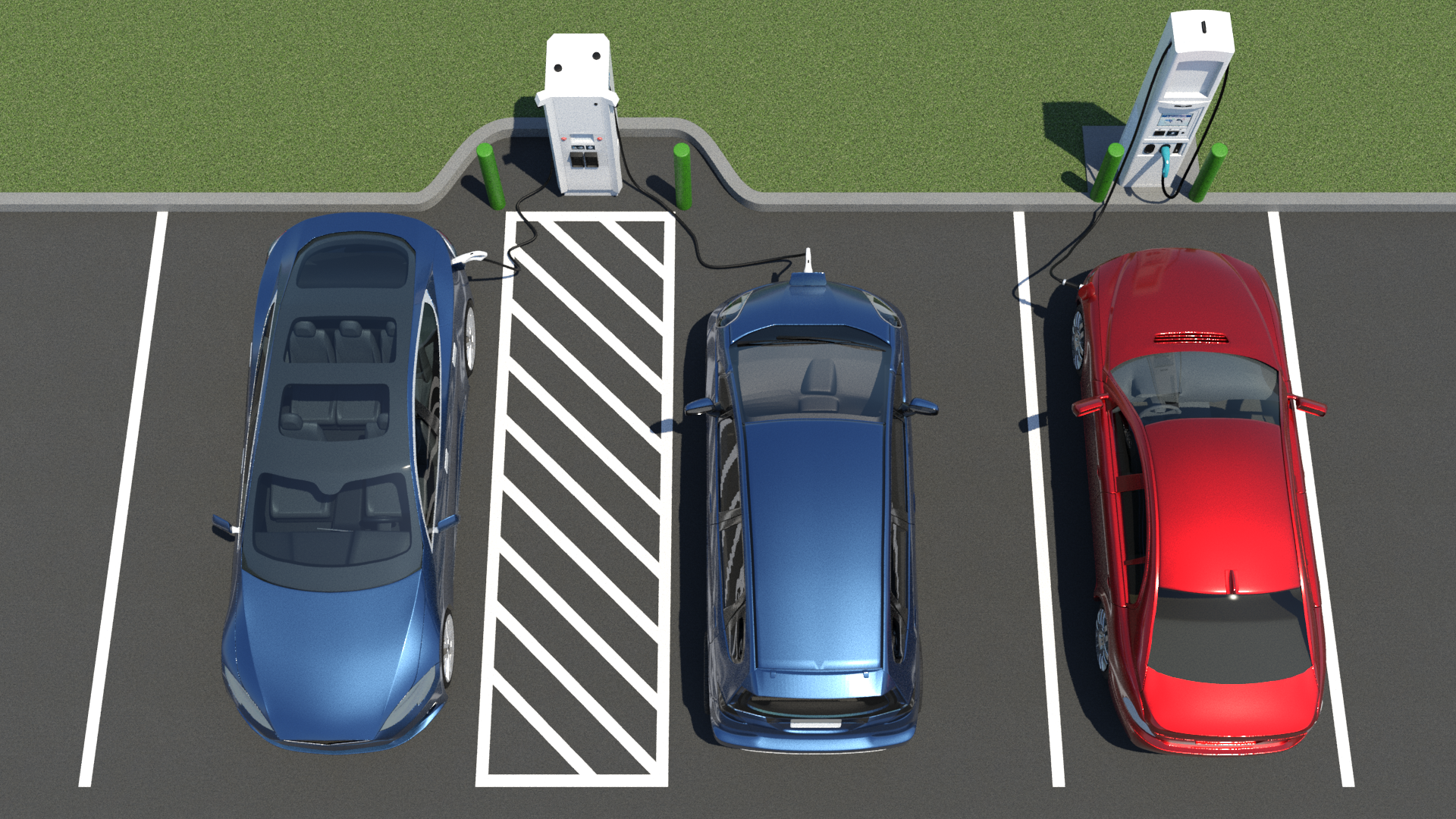
Differences Between Charging Spaces and Parking Spaces
Although EV chargers are often installed in parking lots, there are some significant differences in use that warrant EV charging spaces be treated differently from parking spaces.
EV charging requires drivers with disabilities to exit their vehicle, traverse to the charger, and carry the connector back to their vehicle charging inlet (which may be on the opposite side of where they enter/exit their EV). Since EV’s do not have a standard location for the vehicle charging inlet, maneuverability around the entire EV is needed. Also, as DCFC cables get heavier and shorter to achieve faster charging, EV’s need to be parked in a way that aligns the vehicle charging inlet with the charger, which could conflict with the orientation needed for a driver with a disability to use the access aisle.
By contrast, a driver with a disability can use an accessible parking space as long as the vehicle is oriented with the access aisle; a person with a disability could either pull-in or back-in to the parking spot to get the access aisle on the appropriate side. The additional space provided by an access aisle is needed only by the person with a disability (who may be either a driver or passenger) and additional space on the opposite side of the vehicle is usually not needed.
Because of this fundamental difference in use, this document differentiates between parking and EV charging, and primarily focuses on the needs of an EV driver with a disability. The needs of passengers with disabilities are not addressed in this document because it is presumed passengers with disabilities could enter or exit the vehicle at a nearby accessible parking space or passenger loading zone.
Existing Requirements that Apply to EV Charging Stations
Various accessibility standards may apply to EV charging stations, including:
Under the ADA and ABA Accessibility Standards, EV charging stations must comply with the technical requirements for floor and ground surfaces (§302), clear floor or ground space (§305), reach ranges (§308), operable parts (§309), accessible routes (§402), and other provisions when needed, such as some of the provisions in parking (§502), signs (§703), and fare machines (§707). See 36 C.F.R. §1191.1 .
EV chargers developed, procured, maintained, or used by federal agencies must also comply with the revised Section 508 Standards. See 36 C.F.R. §1194.1 , App. A and C . This includes that the user interface (UI) be accessible. EV chargers which do not incorporate a display screen would not be required to be speech-output enabled, but are still ICT and would have accessibility requirements if they are any more complicated than just plugging it in.
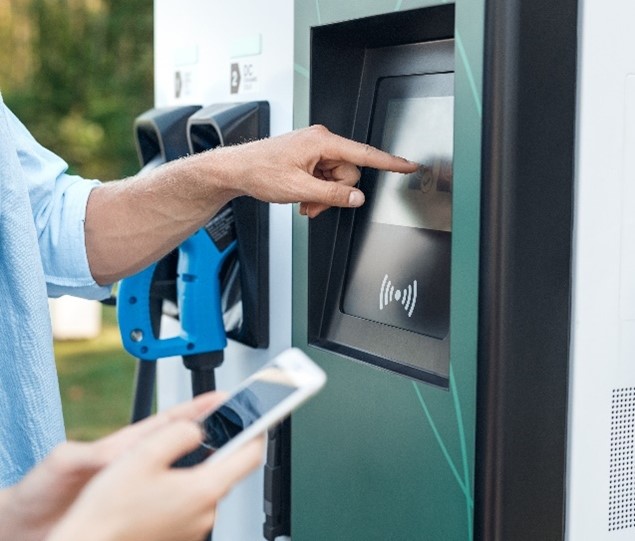

Accessible EV Chargers
Unlike gas stations where an attendant may be available to assist with refueling vehicles, EV charging stations are often unattended. Thus, it is important that EV charging stations be sufficiently accessible to allow independent use by drivers with disabilities, including people who have limited or no hand dexterity, limb differences, or upper extremity amputations and use adaptive driving controls.
Two aspects of accessibility need to be considered:
Accessible mobility features
A reasonable number of EV chargers must have physical access for people who use mobility devices, such as wheelchairs, scooters, walkers, and canes. Accessible mobility features primarily concern the size of the vehicle charging space, providing access aisles, how and where the chargers are installed, and the physical operability of the charger. Also see: Number of accessible chargers
Accessible communication features
All EV chargers should have accessible communication features and operable parts. This enables EV chargers to be used by people who are deaf or hard of hearing, little people, and other people with disabilities who do not need accessible mobility features (like access aisles) to use an EV charger.
All EV chargers containing ICT that are developed, procured, maintained, or used by the federal government must comply with the Section 508 Standards and have accessible ICT, including accessible hardware, software, and operable parts.
Accessible Mobility Features
EV chargers designed to serve people who use mobility devices must be located on an accessible route and should provide:
- a vehicle charging space at least 11 feet wide and 20 feet long
- adjoining access aisle at least 5 feet wide
- clear floor or ground space at the same level as the vehicle charging space and positioned for an unobstructed side reach
- accessible operable parts, including on the charger and connector
These mobility features allow sufficient space for a person who uses a mobility device to exit and maneuver around the vehicle, retrieve the EV connector, and plug the connector into the electric vehicle charging inlet. Since EVs do not have a uniform vehicle charging inlet location, a larger vehicle charging space is needed to maneuver around all sides of the electric vehicle.
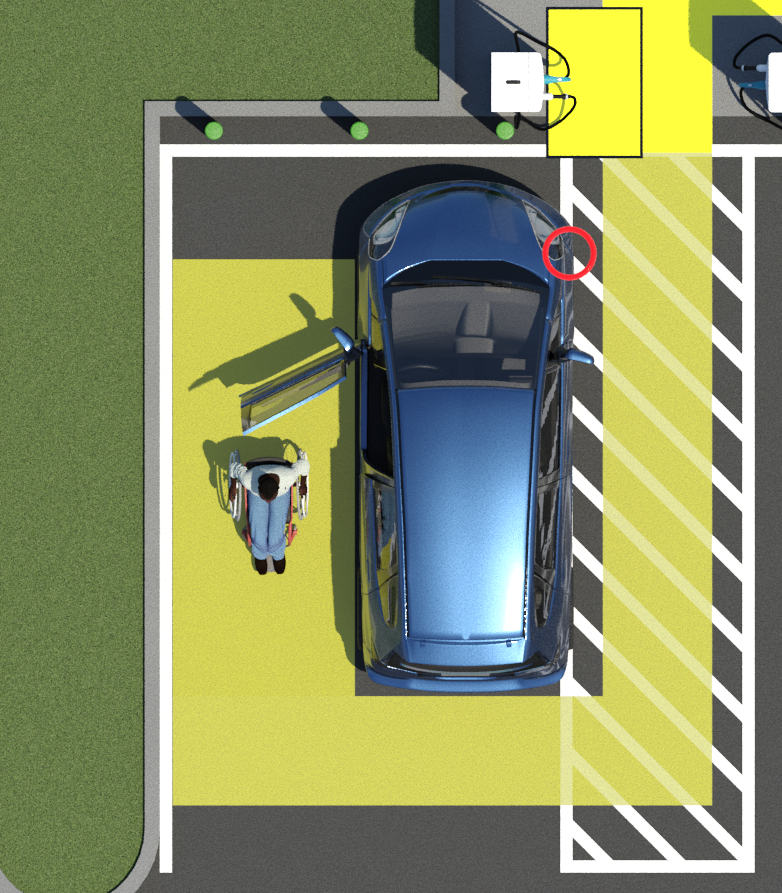
Accessible Routes
EV chargers with accessible mobility features must be connected to an accessible route (§206.2.2; §402). The technical requirements for accessible routes can be found in Chapter 4 of the ADA and ABA standards as well as in the Access Board’s technical guides on accessible routes , including walking surfaces (§403), curb ramps (§406), and ramps (§405).
Electric Vehicle Charging Space and Access Aisle
EV charging spaces with mobility features should provide a vehicle space with a minimum width of at least 132 inches (11 feet) and a minimum length of at least 240 inches (20 feet). Adjacent to the vehicle charging space should be an access aisle that is at least 60 inches (5 feet) wide and the full length of the vehicle charging space. A vehicle charging space at least 11 feet wide and 20 feet long would provide sufficient space to maneuver around an electric car, but larger vehicle charging spaces may be needed for electric trucks.
Where vehicle charging spaces are marked, access aisles should also be marked to discourage parking in them. State or local codes may have specific requirements for marking and signing access aisles (e.g., access aisle markings in blue or “no parking in access aisle” signs). The width of the vehicle charging spaces and access aisles is measured to the centerline of markings, but it can include the full width of lines where there is no adjacent vehicle space or access aisle.
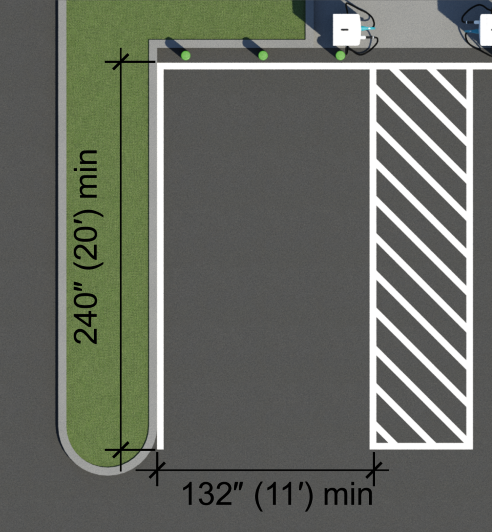
One access aisle may be shared by two vehicle charging spaces, or a charging space and a parking space, but overlap of the aisle should be limited to 60 inches (5 feet). The exception in §502.2 that leads to two 8-foot accessible parking spaces sharing an 8-foot access aisle should not be used for vehicle charging spaces because there would be insufficient space to access the vehicle charging inlets on the opposite side of the access aisle.
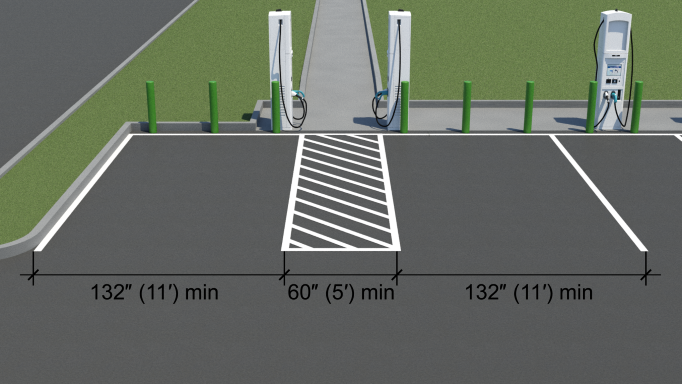
Access aisles should not be blocked or obscured by curbs, wheel stops, bollards, or charging cable slack. Floor or ground surfaces of vehicle charging spaces and access aisles should comply with §302 and not have changes in level or slopes that exceed 1:48. For more information, please consult the Access Board’s guide on floor and ground surfaces and guide on parking spaces .
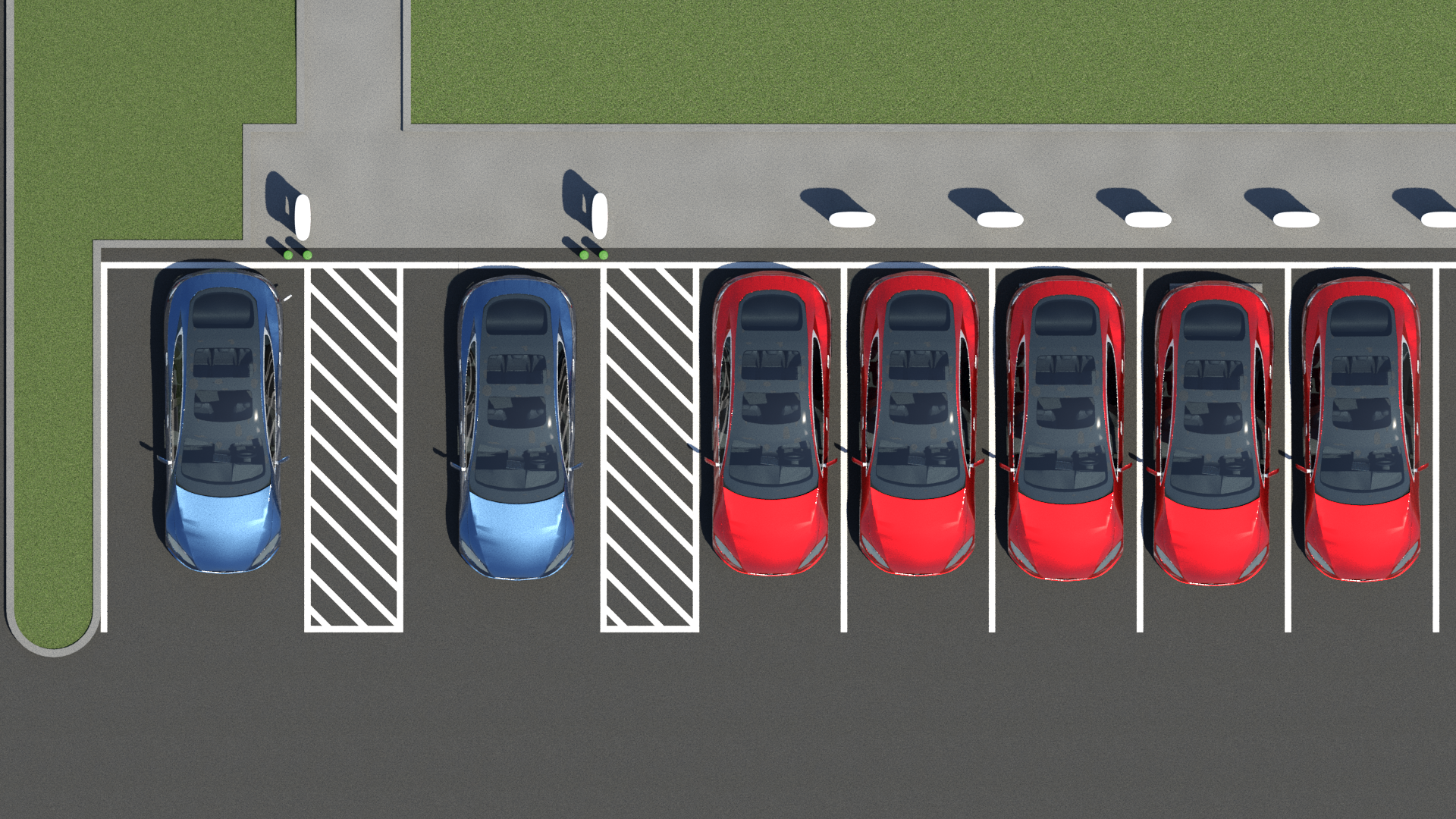
Access Aisle Relation to EV Charger
The access aisle must be connected by an accessible route to the clear floor or ground space at the EV charger.
When charging cables are short, the charger should be positioned so that the operable parts and clear floor or ground space are on the same side as the access aisle. This configuration allows for placement of bollards to protect chargers without obstructing clear floor or ground space.

EV chargers with long charging cables have more flexibility regarding placement. With long charging cables, chargers can be placed at the center of the vehicle space or access aisle, or between vehicle spaces, if ample room is available for maneuvering around and between bollards. For more information, please consult sections Clear Floor or Ground Space and Example Charging Scenarios of this technical assistance document.
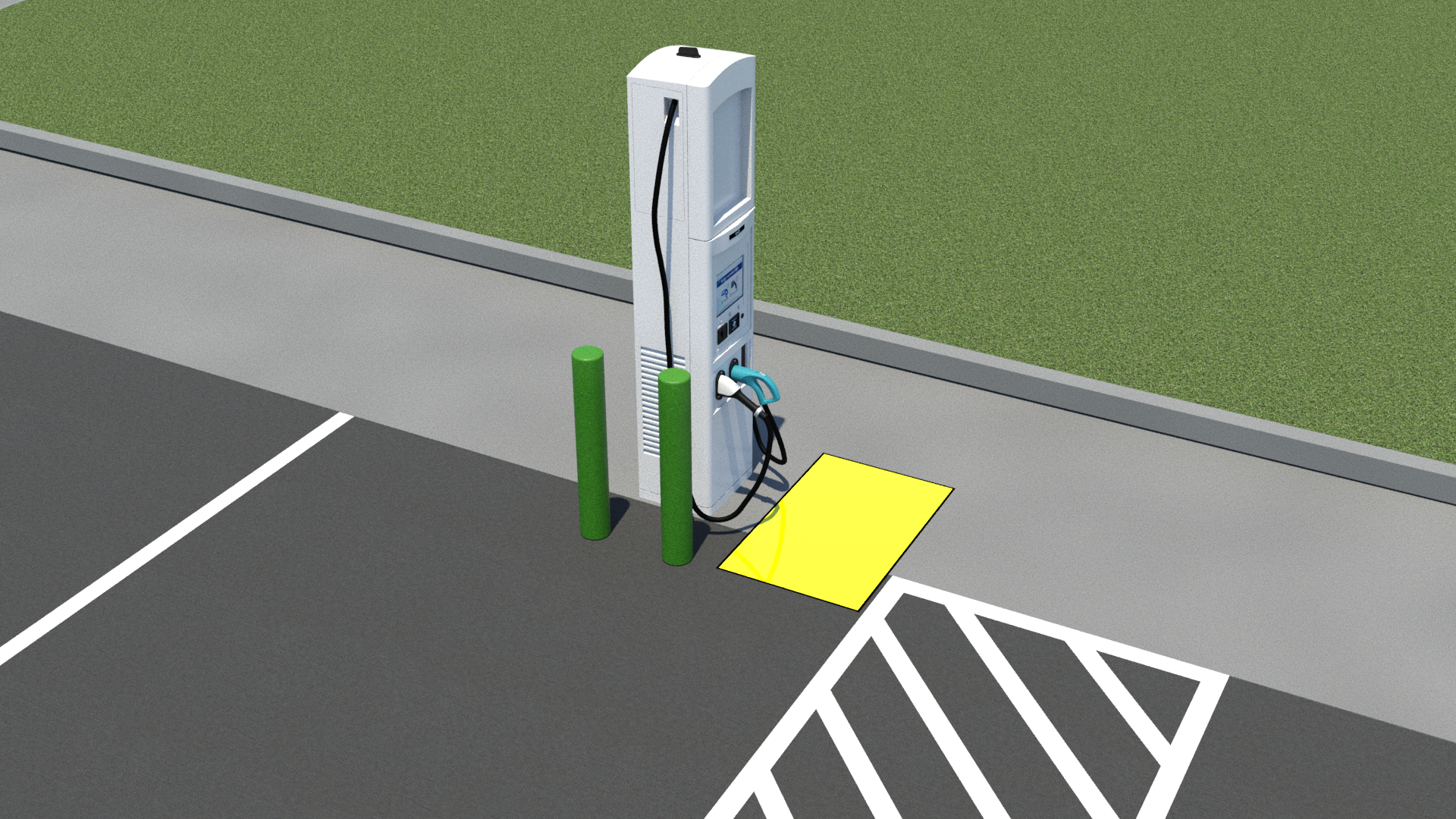
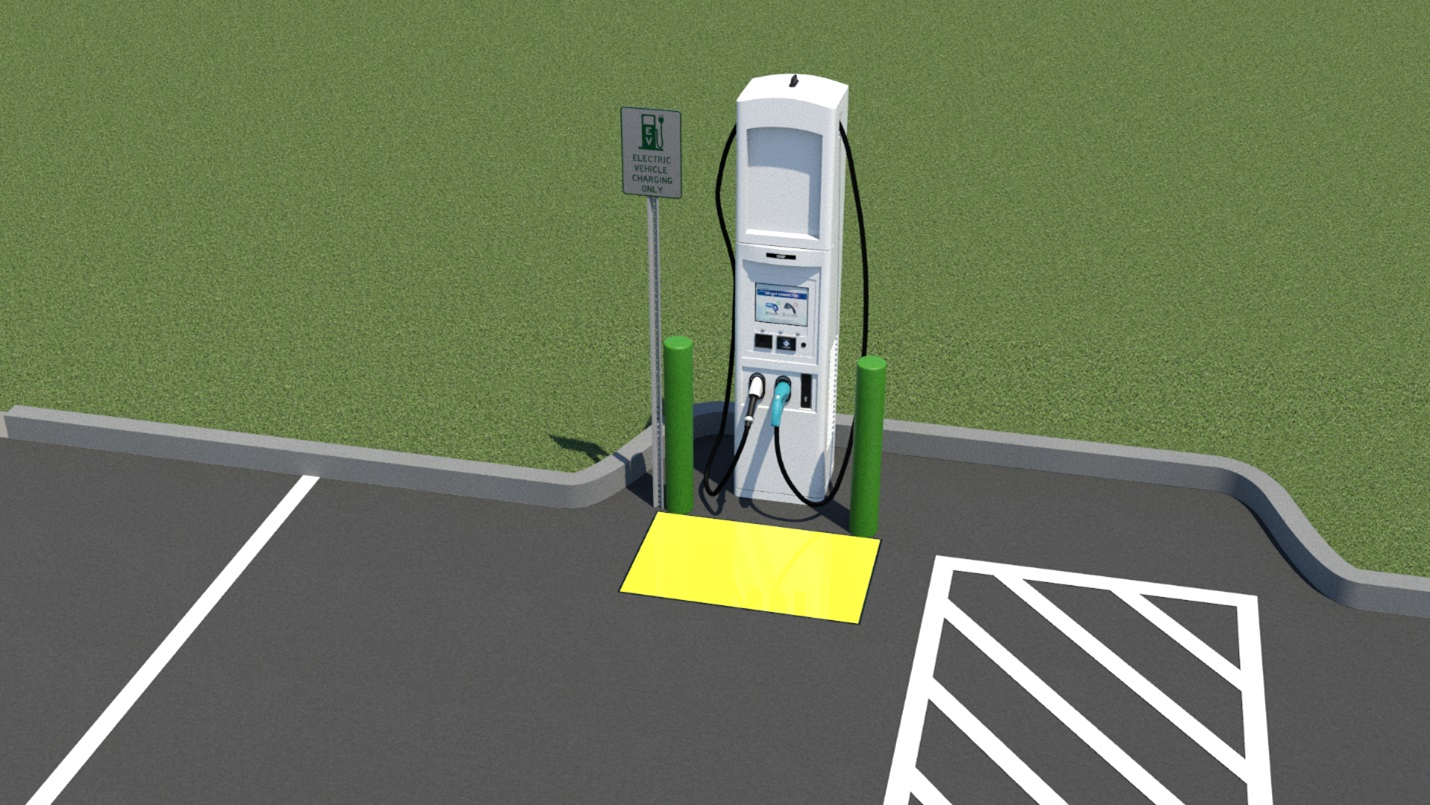
Alignment of Charger with Location of Vehicle Charging Inlets
The placement of the vehicle charging inlet varies across make and model of EVs. This variety can create challenges to designing an EV charging space with accessible mobility features that can meet the needs of all types of EVs since the vehicle charging inlet needs to align closely to the charger, especially for DCFC with short charging cables. Generally, a person with a disability driving an EV will need the access aisle positioned on the driver’s side.
Examples of Vehicle Charging Inlet Locations
| Make | Model | Charging Inlet Location |
|---|---|---|
| Tesla | S, 3, X, Y | Driver side rear |
| Chevrolet | Bolt EV | Driver side front |
| Ford | Mustang Mach-E | Driver side front |
| Ford | E-transit | Front |
| Nissan | Leaf | Front |
| Audi | E-Tron | Driver side front |
| Volkswagen | ID .4 | Passenger side rear |
| Porsche | Taycan | Passenger side front, driver side front |
| Hyundai | Kona | Front |
| Hyundai | Ionic | Driver side front |
| Toyota | Prius plug-in | Passenger side rear |
| Honda | Clarity plug-in | Driver side front |
| Ford | Fusion energi | Driver side front |
| Toyota | RAV4 prime | Passenger side rear |
| Chrysler | Pacifica hybrid | Driver side front |
When designing a charging station to serve multiple types of EV’s with various vehicle charging inlet locations, it is recommended to provide more mobility accessible vehicle charging spaces with a variety of access aisle locations and charger configurations.
Example Charging Scenarios
The scenarios below indicate how a vehicle’s orientation changes depending on the location of the vehicle charging inlet. This is particularly important for DCFCs with short and heavy charging cables. AC Level 2 and some DCFCs that have sufficiently long and light cables may not have this issue.
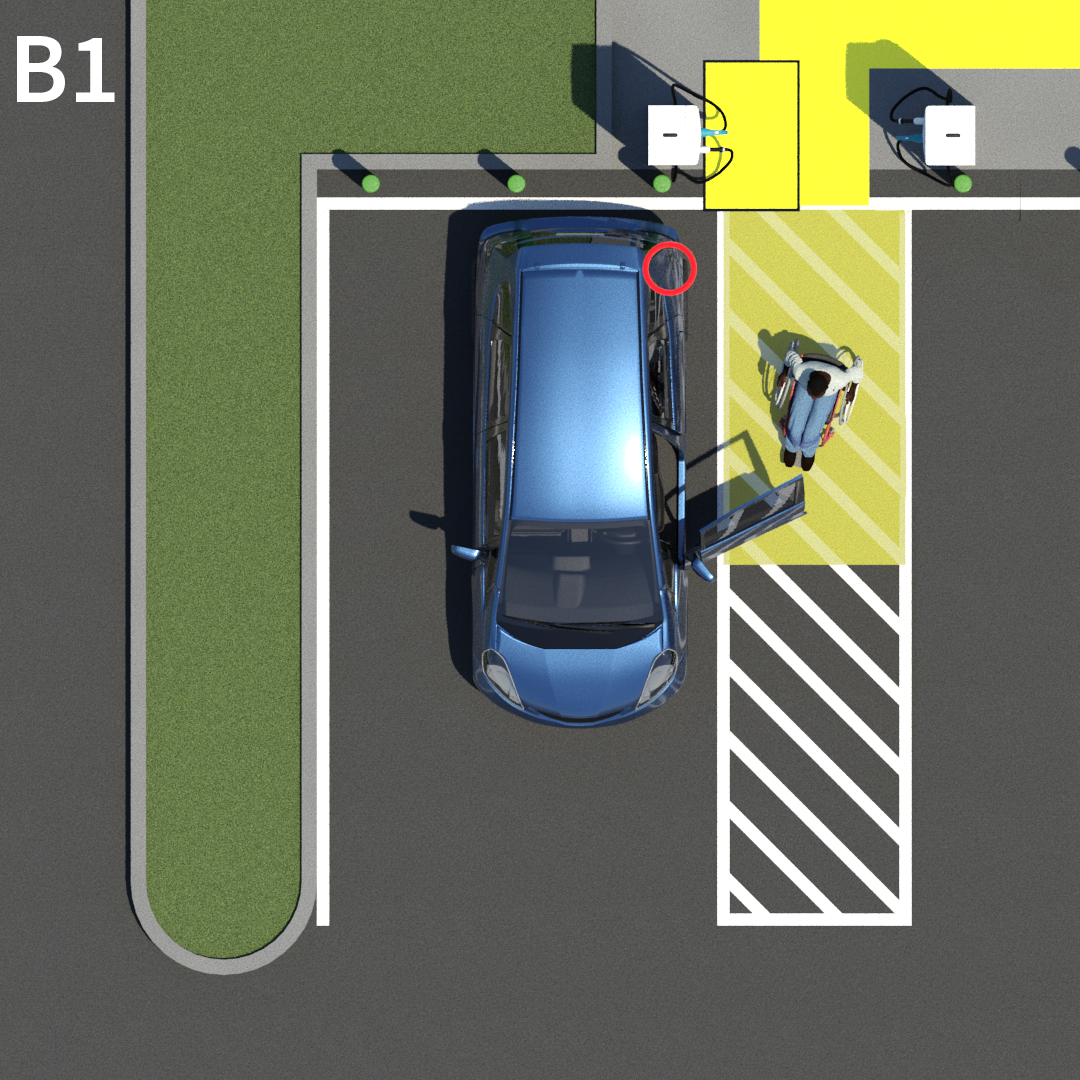
B1 depicts an ideal scenario with the most common EV charging inlet location, which is on the driver side rear. When the vehicle is backed into the vehicle charging space, the driver side door is aligned with the access aisle and the vehicle charging inlet is close to the EV charger. The EV charger is located at the same level as the charging space and access aisle by depressing the curb to the same level as the asphalt. The EV charger has been rotated so that the clear floor or ground space is on the same side as the access aisle and not obstructed by bollards. Bollards are used instead of wheel stops to provide ample maneuverability around the vehicle.
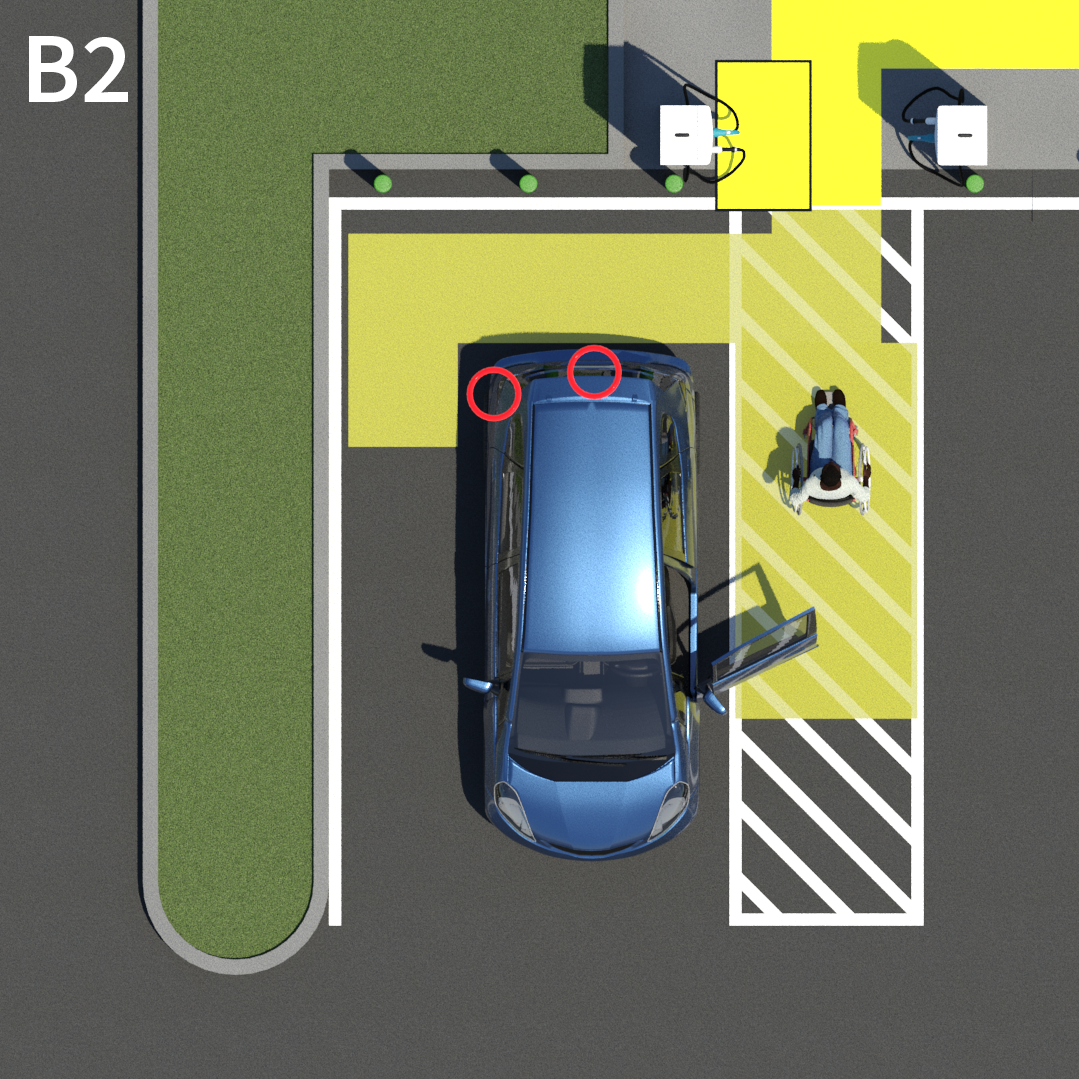
B2 depicts a vehicle backed into a charging space, but the vehicle’s charging inlet is located on either the rear or passenger side rear. While the access aisle is still aligned with the driver side door, the vehicle now needs to be spaced at least 36 inches (3 feet) away from the bollards in order for mobility device users to pass between the vehicle and bollards and reach a charging inlet located on the opposite side of the vehicle.
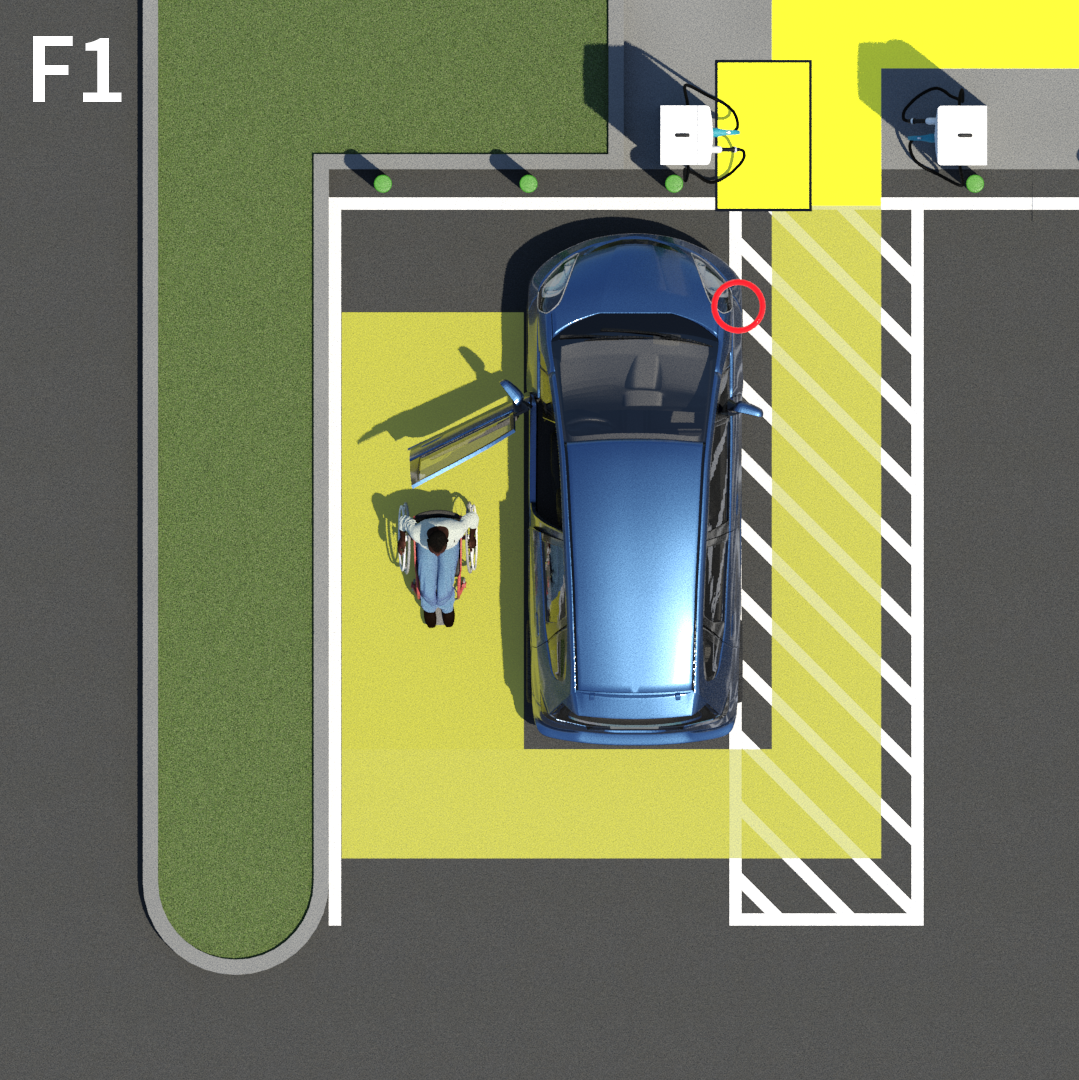
F1 depicts a vehicle pulled forward into the EV charging space. The access aisle is now on the passenger side, but the vehicle charging inlet located on the passenger side front aligns closely with the EV charger. A mobility device user would need 5 feet of space on the driver’s side to exit the vehicle, and at least 3 feet of space to travel around the rear of the vehicle and to the EV charger. This may require the EV to partially overlap the access aisle. A vehicle charging space at least 11 feet wide and 20 feet long would provide sufficient space to maneuver around an electric car. Large electric SUVs and trucks may need larger vehicle charging spaces.
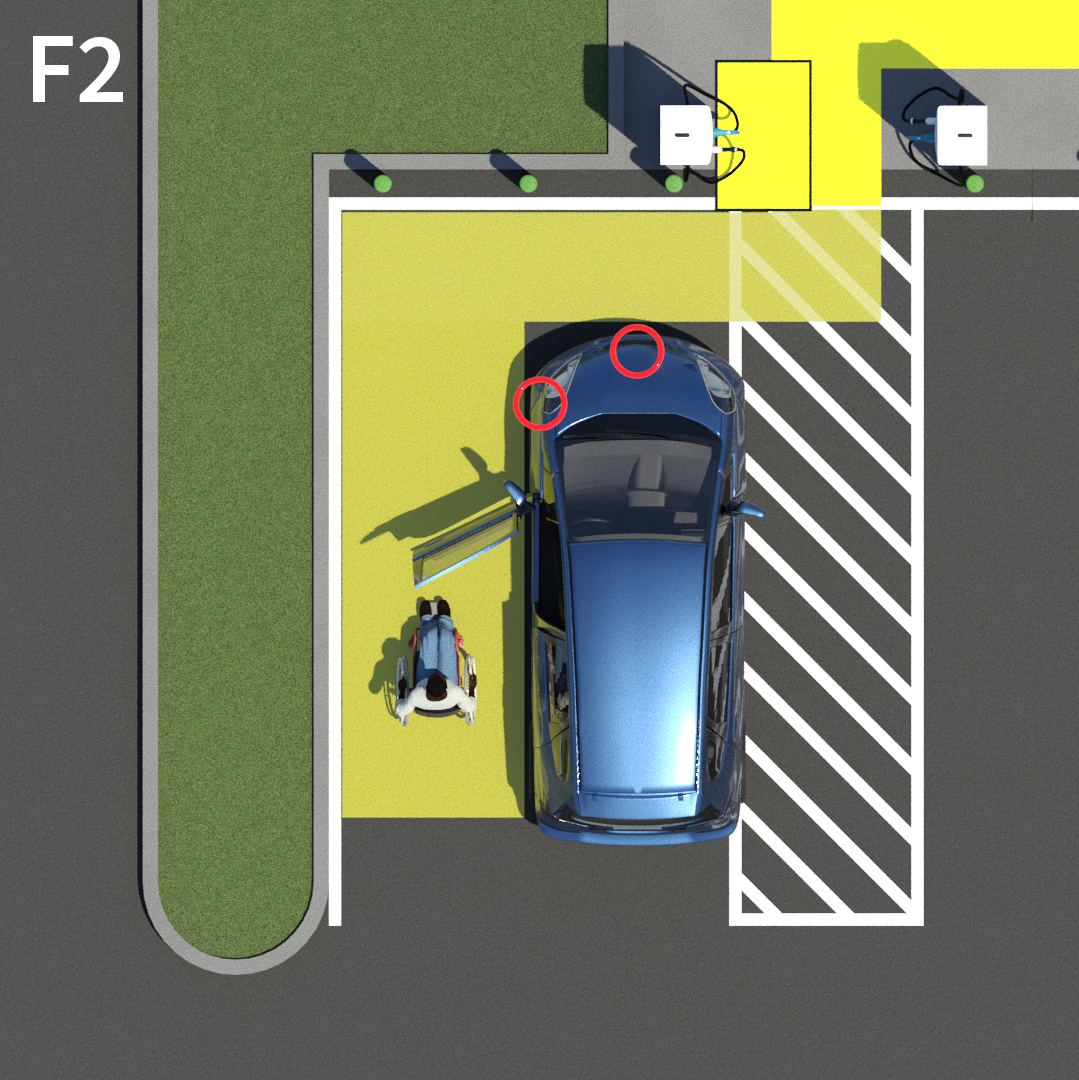
F2 depicts a similar scenario of a vehicle pulled forward into the vehicle charging space, but the vehicle charging inlets are either on the front or driver side front, which requires passing between the EV and bollards.
Charging may not be achievable if cables are too short in scenarios F2 and B2. A better solution is to design the adjacent vehicle charging space to also have accessible mobility features. With two mobility accessible vehicle charging spaces sharing a common access aisle, a variety of charging inlet locations can be served. Longer charging cables should also be provided.
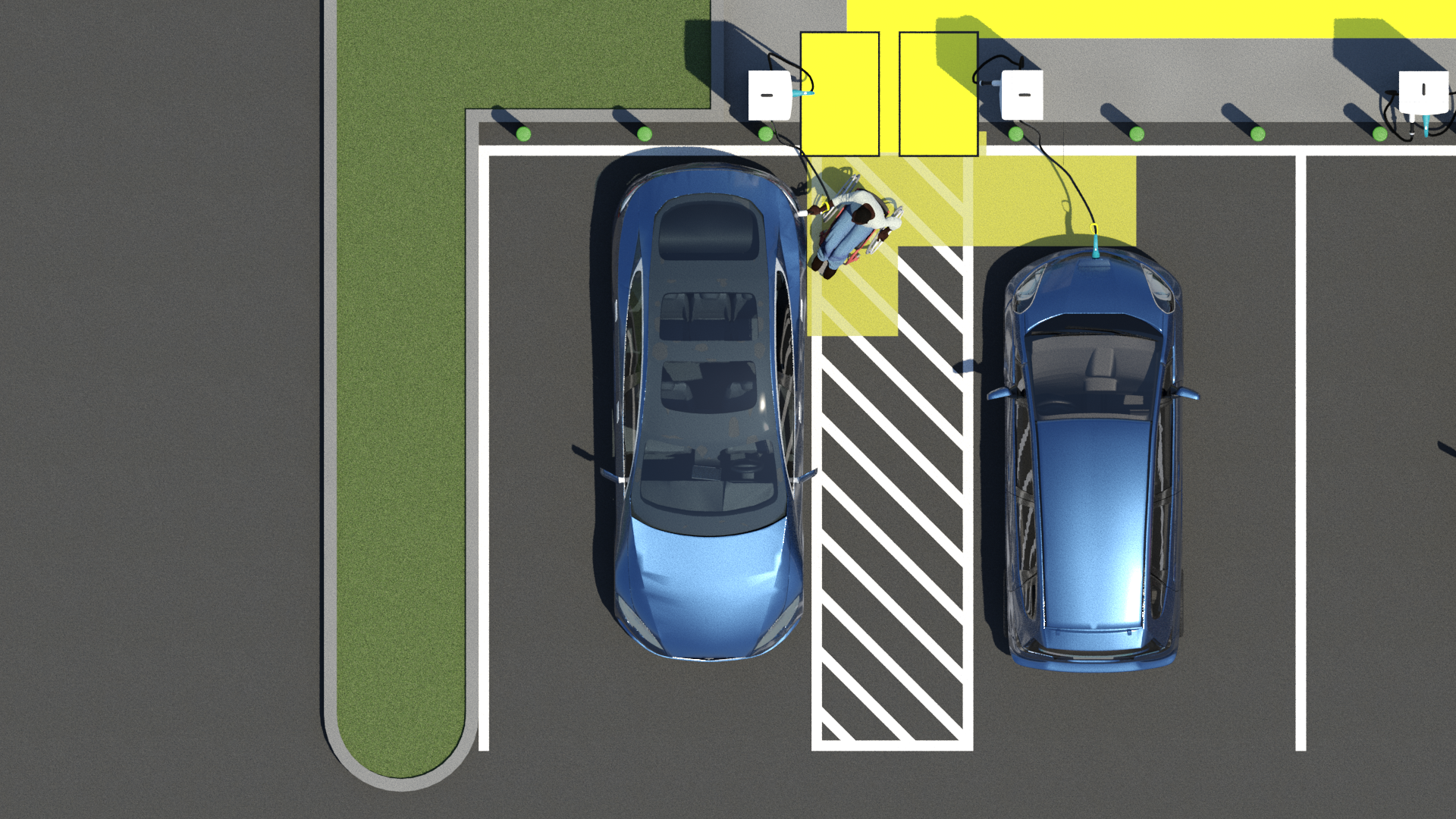
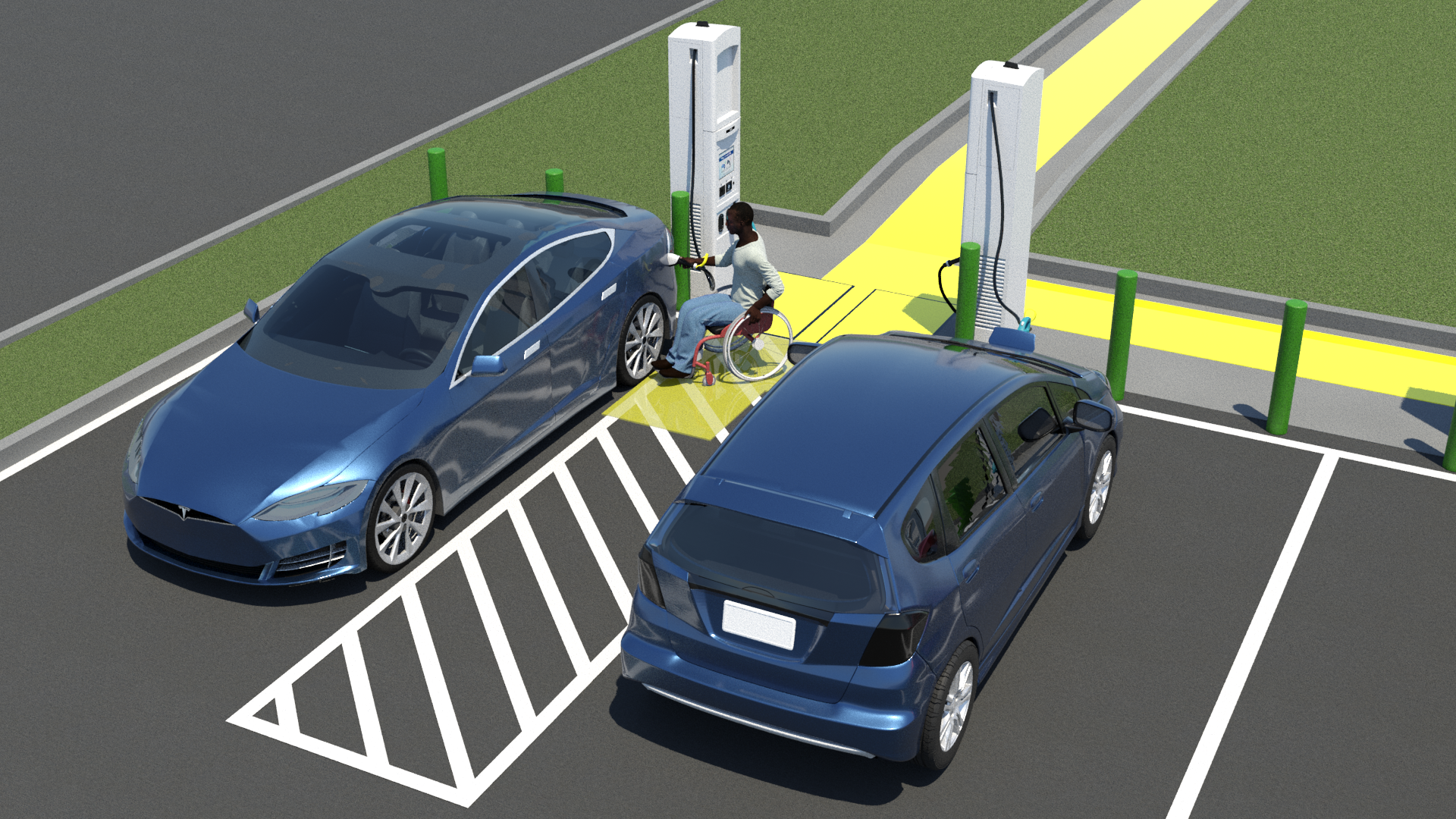
Charging stations designed to serve specific vehicles with consistent and known vehicle charging inlet locations should provide access aisles on the driver side and ensure the vehicle charging inlets align closely with the EV charger.
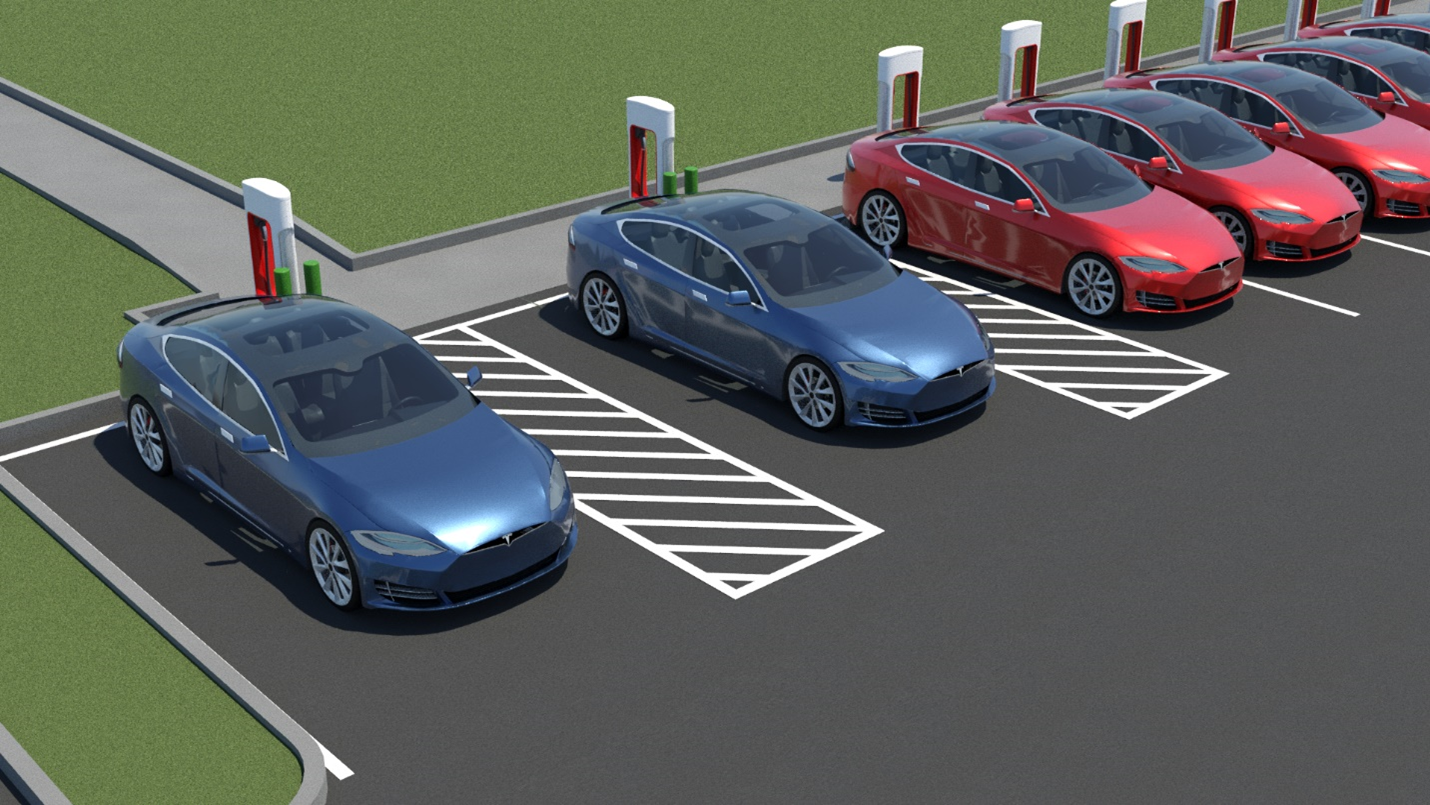
Clear Floor or Ground Space
To provide accessibility for people who use mobility aids, such as wheelchairs, scooters, walkers, and canes, EV chargers must provide a clear floor or ground space complying with §305 and be located on an accessible route. Clear floor or ground spaces must meet requirements for ground and floor surfaces, including criteria for firmness, stability, and slip resistance. They must be free of changes in level and not sloped more than 1:48. Grass, curbs, wheel stops, and bollards may not be located within the clear floor or ground space.
Clear floor or ground space at chargers must be a minimum of 30 inches by 48 inches. Additional space may be required where the clear floor or ground space is confined on three sides and obstructed for more than half the depth (e.g., bollards, curbs, etc.).
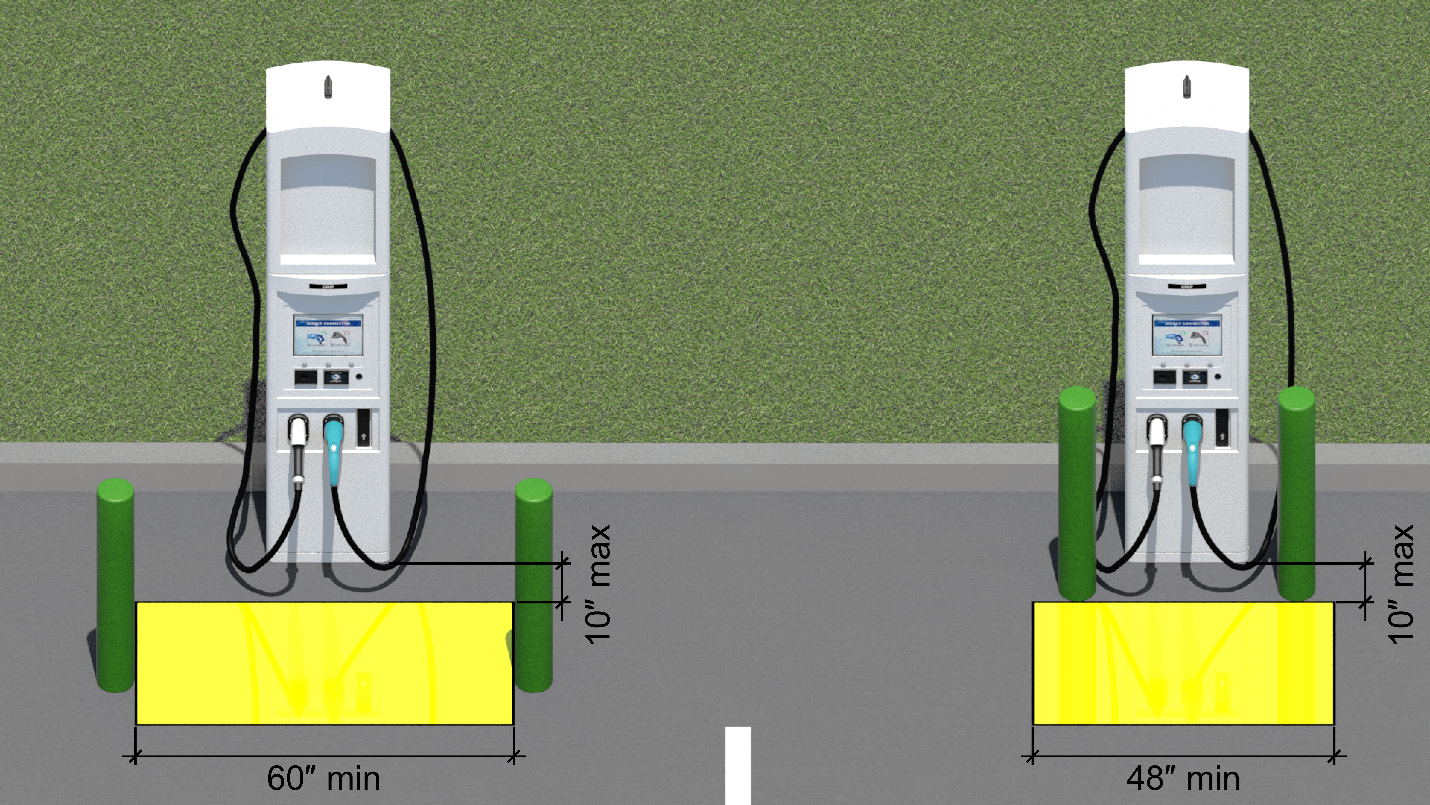
While both a forward approach and parallel approach are permitted under the ADA and ABA Standards, it is recommended that the clear floor or ground space be positioned for a parallel approach to the charger and centered on the operable part. If there are multiple operable parts, the clear floor or ground space should be centered on the EV charger.
EV chargers are highly recommended to be installed at the same level as the vehicle charging space and access aisle so that the clear floor or ground space can be placed as close as possible to the EV charger. This design ensures people who use mobility devices can readily access chargers.
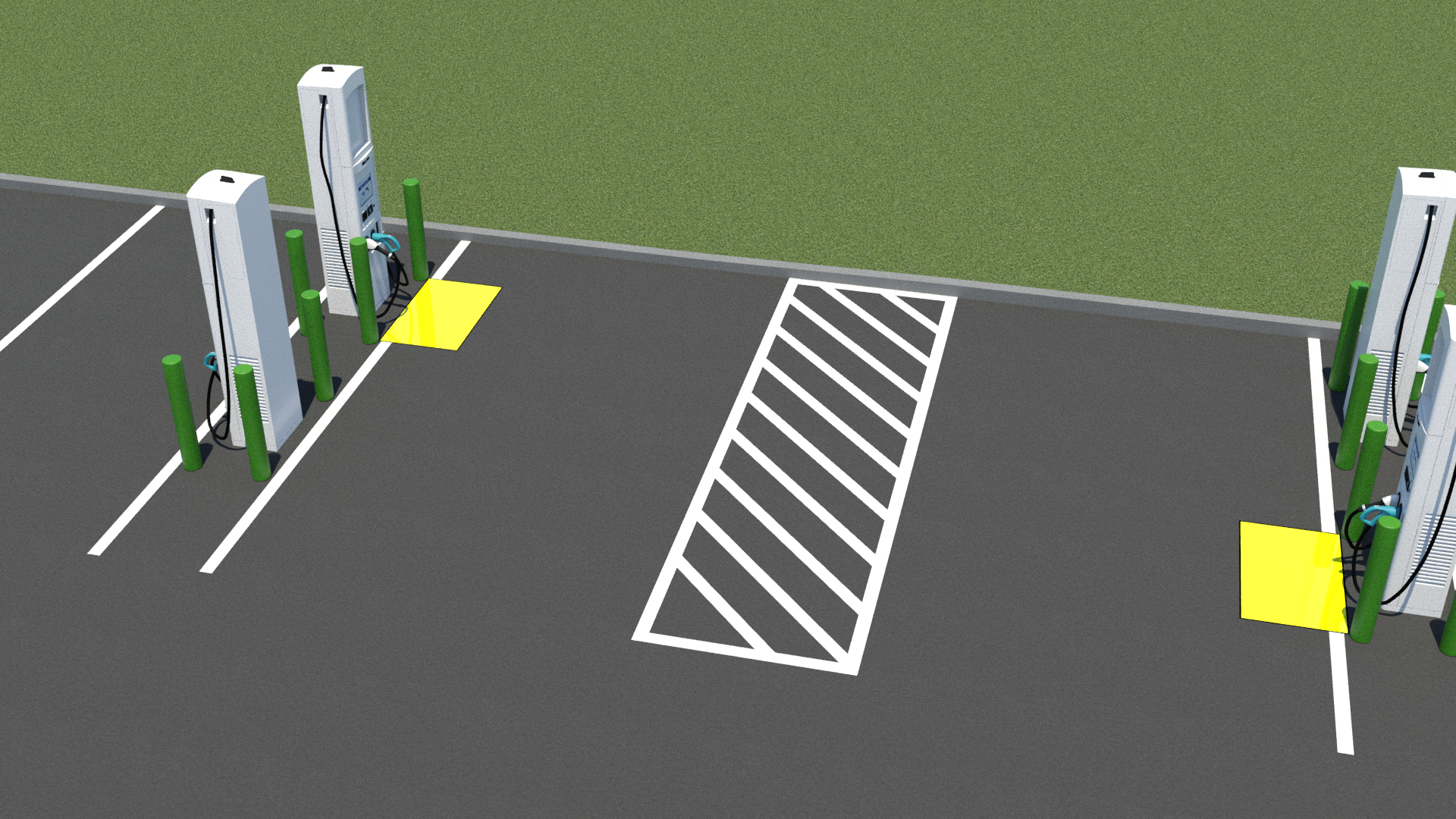
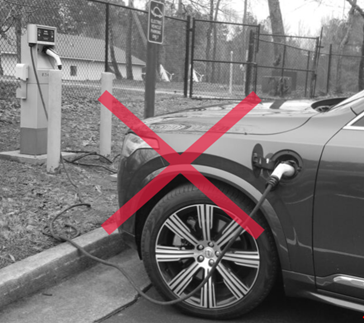
Avoid installing accessible EV chargers on top of or behind curbs. Where chargers are installed on or behind curbs, people using wheelchairs have very limited access to approaching and using them. Depending on users’ ability, reaching the operable parts may be difficult if not impossible.
If EV chargers must be installed on a curb, such as at on-street parking, place them as close to the edge of the face of the curb as possible and no farther than 10 inches away from the face of the curb.
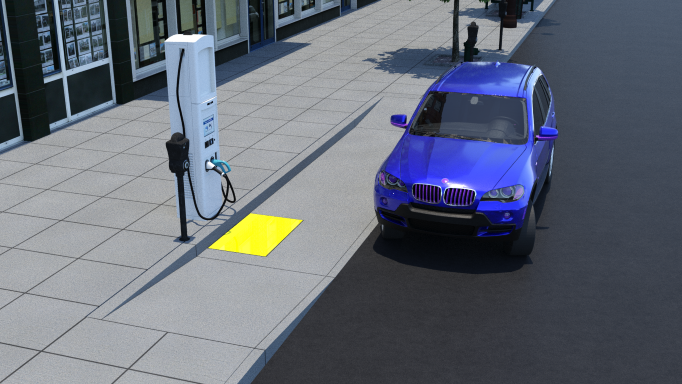
Alternatively, the EV charger and a clear floor or ground space can be placed up on the curb or sidewalk, but this design should only be used at existing curbs when it is technically infeasible to lower the curb or sidewalk. The front of the charger should not face the street or curb, and charging cables should be sufficiently long and light enough to allow mobility device users to travel back down the curb ramp and reach their vehicle charging inlet. Reaching some vehicle charging inlets may only be achievable with long charging cables, and DCFCs may be limited to charging only vehicles that have charging inlets that can be reached from the sidewalk. (Also see: On-Street EV Charging Stations Design)
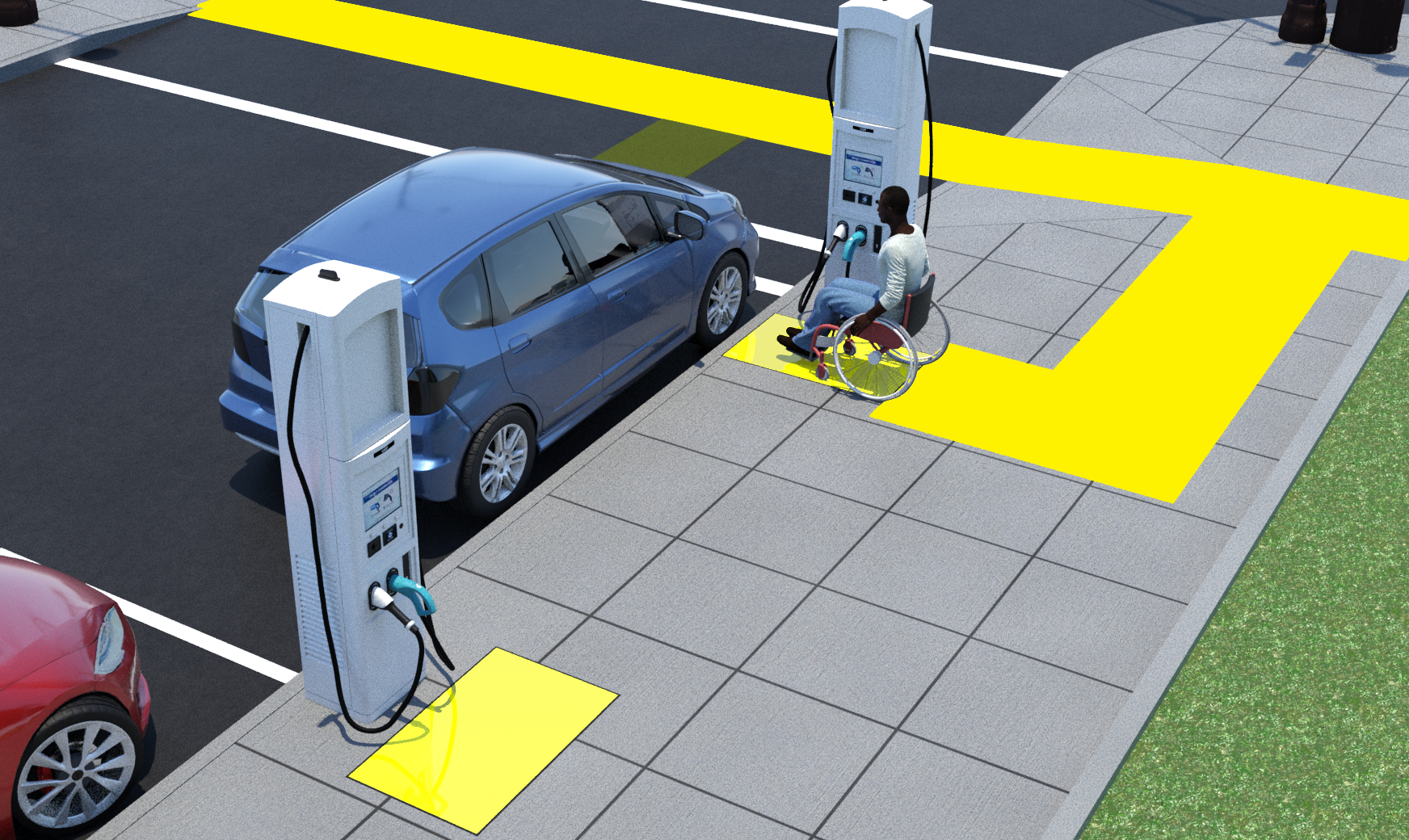
When possible, providing additional clear floor or ground space for a forward approach and turning space is recommended. Aligning the EV charger with the access aisle takes advantage of existing clear floor or ground space.
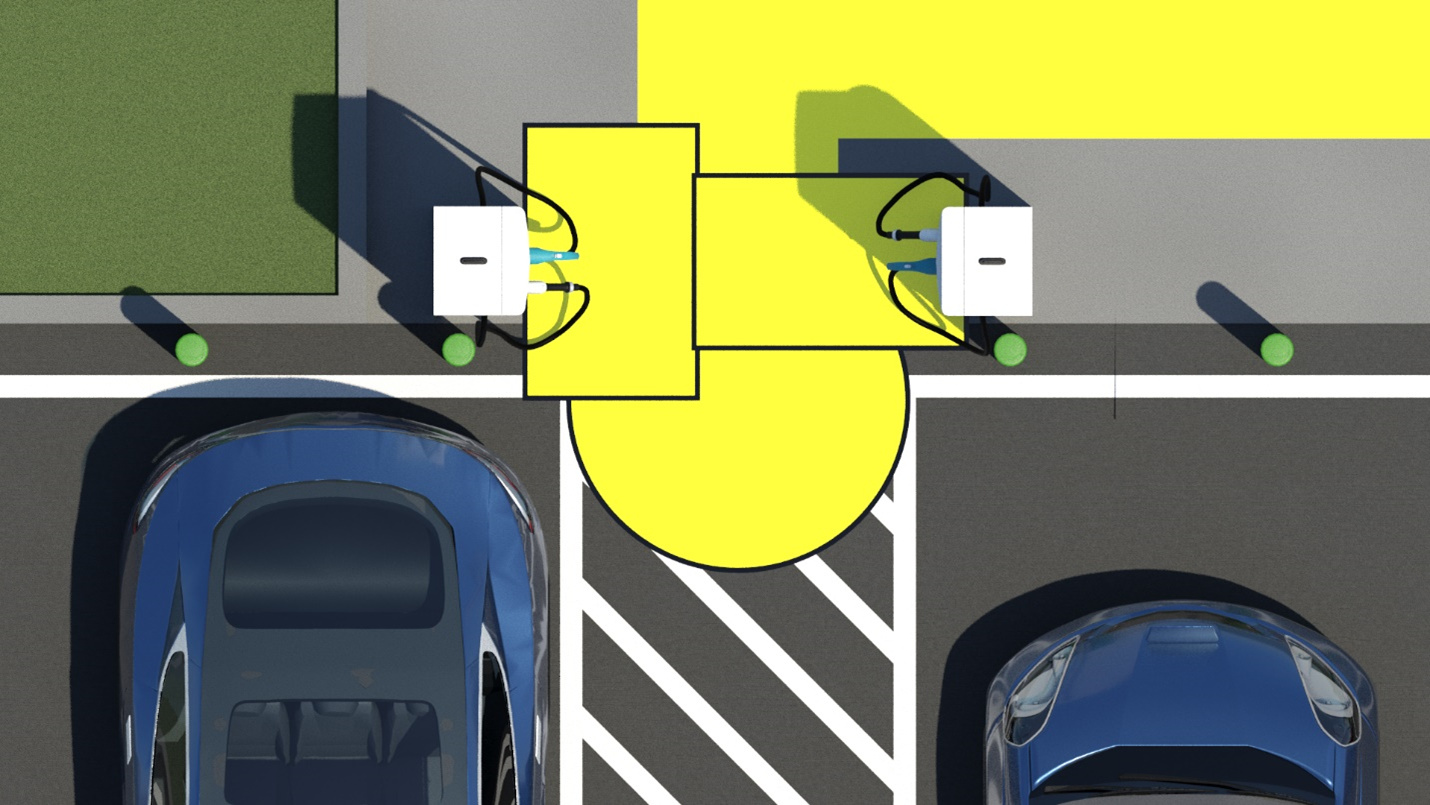
Operable Parts within Reach Range
At a charging station, a reasonable number of EV chargers must comply with §205 Operable Parts , including technical requirements for clear floor or ground space ( §305), reach ranges& (§308), and| operation ( §309). We recommend EV chargers be designed with parts that are operable by the widest range of users with disabilities, including people with limited or no hand dexterity, limb differences, or upper extremity amputations.
Operable parts on EV chargers include, but are not limited to, the connector, card readers, electronic user interfaces, and switches and buttons, including the emergency start/stop button.
Unobstructed side reach
All operable parts should meet the requirements for an unobstructed side reach (§308.3.1 ) and be no higher than 48 inches above the clear floor or ground space and no farther than 10 inches away. The exception for fuel dispensers should not be used (See: fuel dispensers). Placing operable parts higher than the 15 inch minimum is recommended.
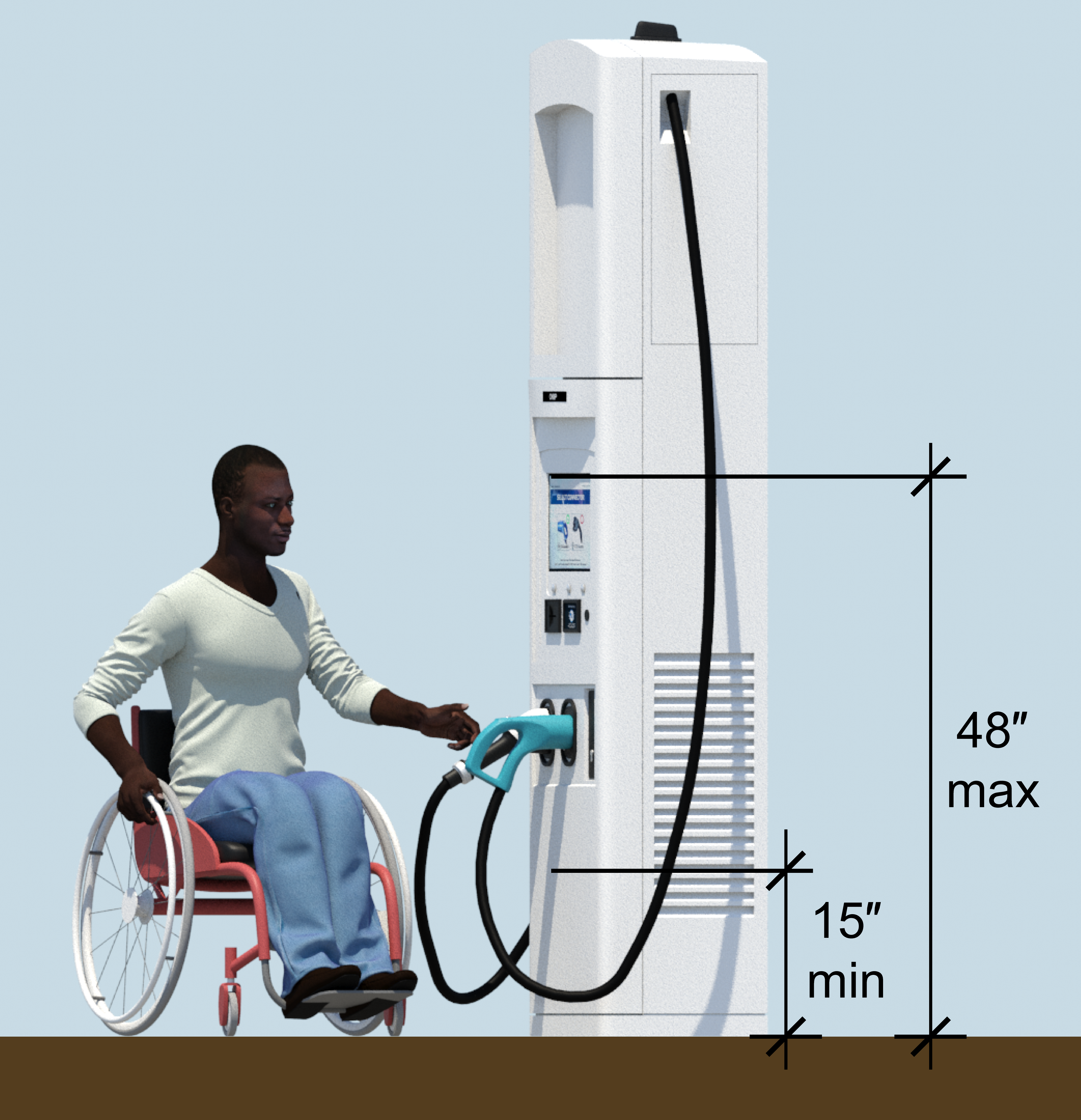
The operable portion must be within an accessible reach range, but non-operable portions can be located outside of reach ranges. For example, a display screen that does not require user touch input, or has buttons located within reach range, can be located above 48 inches. Similarly a card reader that can be activated below 48 inches with a portion of the card reader above 48 inches would still be operable. The operable portion of the connector, particularly the release button and handle, should be below 48 inches. A connector with no release button that can be used without reaching above 48 inches would also be within reach range.
Connectors
Connectors must meet the requirements for operable parts (§309), including operation with one hand and no tight grasping, pinching, or twisting of the wrist, and no more than five (5) pounds of force to operate.
Connectors generally have a release button that needs to be pressed to connect/disconnect the connector from the vehicle charging inlet. Simultaneously grasping the connector and pressing a release button can be challenging for people with limited hand dexterity. Connectors that are a consistent diameter and very smooth are also challenging because they require grasping, especially when cables and connectors are heavy.
One way to informally test if an element is sufficiently accessible for a person with limited hand dexterity is to try operation of the element with a closed fist. Connector designs that have a handle with a release button on the inside, similar to a fuel dispenser, can be more accessible because a person can often place a closed fist inside of the handle and simultaneously pull on the connector and press the release button. The addition of straps and loops may also help a user carry the connector because it could be looped onto the user’s wrist or arm, or even hung on the user’s mobility device, to free both hands up to maneuver a mobility device (e.g. push a wheelchair, keep both hands on a walker etc.).
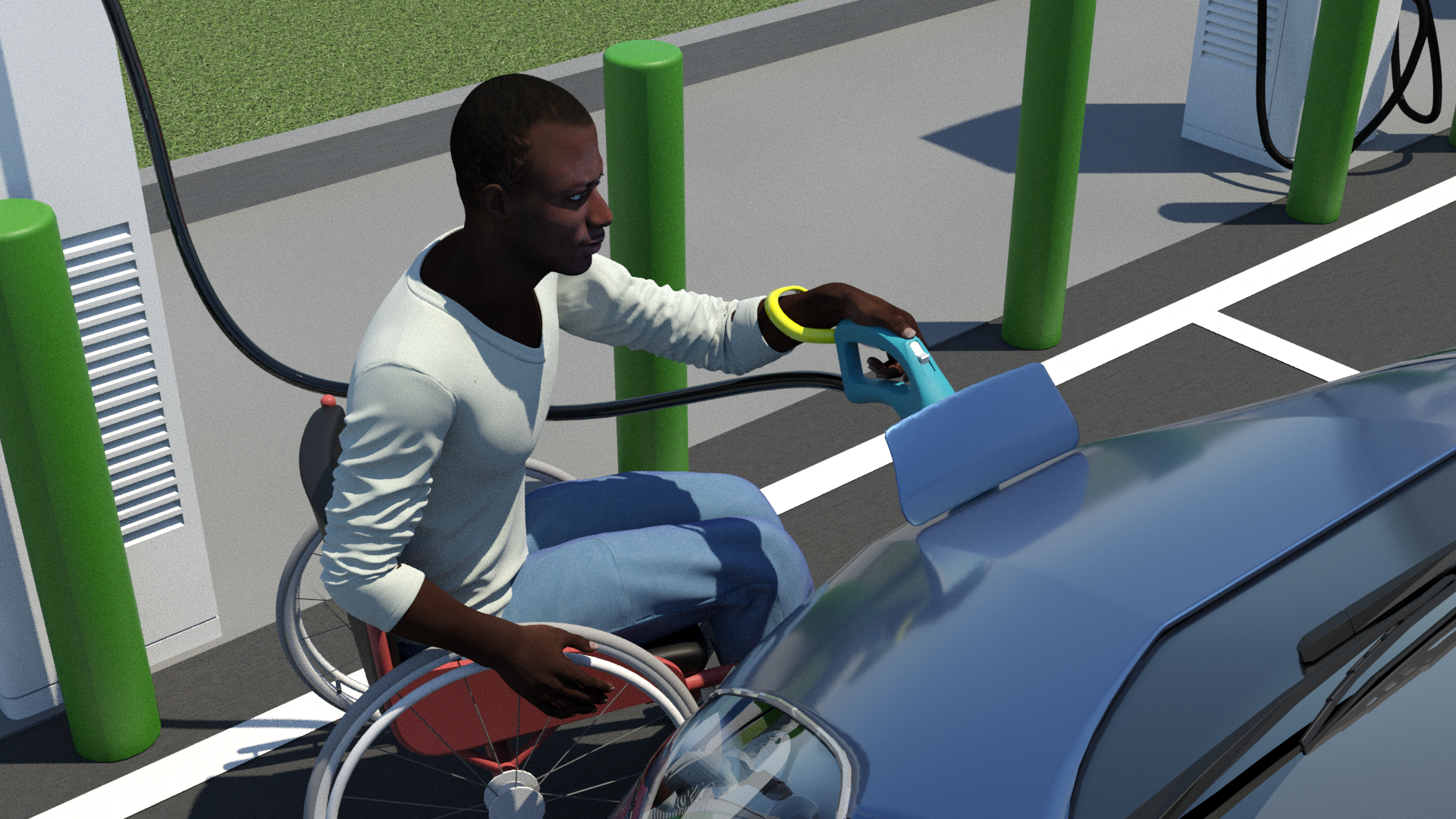
Future connector designs that are more accessible are encouraged. Until more accessible connectors are available, some chargers may be limited to using connectors that require pressing a release button with the thumb.
Manufacturers have developed automatic connection devices, which improve accessibility of EV charging because they eliminate the need to physically manipulate the connector. When possible, consider installing automatic connection devices, especially at fleet charging stations.
Charging Cables
The ADA and ABA Accessibility Standards require operable parts to be operable with no more than 5 pounds of force and to not require tight grasping, pinching, or twisting of the wrist.
Light weight charging cables (AC Level 2, and some DCFCs) should be of sufficient length to charge a vehicle with various charging inlet locations.
As thicker and heavier charging cables are used to achieve faster charging speeds, it becomes more difficult for people who use mobility devices to lift the cable and carry it back and forth to their vehicle charging inlet. Heavier and shorter DCFC cables should be able to charge a vehicle positioned at least 60 inches (5 feet) away and be installed so that users can access the vehicle charging inlet, access aisle, and charger.
Charging cables cannot block or obstruct accessible routes when stored or when connected to vehicles. Cable management systems can be provided to prevent cable slack from accumulating on the ground and potentially offset the weight of heavier DCFC cables, but cable management systems must be kept in good condition to maintain the accessibility of the chargers. Overhead cable management systems may also be able to help with cable weight and operation, but the systems and cables must not become protruding objects.
There are many promising solutions to the issue of heavy charging cables, including the use of cable management systems, automatic connection devices, and wireless charging, which could greatly improve accessibility. In the interim, however, the benefits of fast charging provide greater user convenience and should be available at accessible EV charging stations, even if the issue of charging cable weight has not been addressed. Persons with disabilities should still have access to DCFCs and not be restricted to AC Level 2 chargers. Future innovations may address the issue of charging cable weight and should be used when available to achieve accessible operation.
Accessible Communication Features
Accessible communication features enable people who are deaf or hard of hearing, people with vision impairments (but who drive), little people, and other people with disabilities who might not need accessible mobility features (like access aisles) to use an EV charger.
All EV chargers should have accessible communication features and operable parts. All EV chargers that are procured or maintained by a federal agency must comply with the Section 508 Standards because they are Information Communication Technology (ICT). See 36 C.F.R. §1194.1 , App. A & C.
Although the ADA and ABA Accessibility Standards have technical requirements for ATM and fare machines (§707), and two-way communication systems (§708) that could be informative, only the Section 508 requirements are referenced in this section of the document because they are similar, but more detailed.
Section 508 addresses hardware accessibility with technical requirements in Chapter 4, including §402 Closed Functionality , §407 Operable Parts , §408 Display Screens , §409 Status Indicators , §410 Color Coding , §411 Audible Signals , and §412 ICT with Two-Way Communication .
Although a number of provisions are specific to the accessibility needs of people who are blind and low vision and who cannot drive a vehicle, the provisions are still applicable to EV chargers purchased or used by federal agencies. Entities concerned only with ADA requirements may have a limited need for certain accessible communication features (e.g. braille instructions, tactilely discernible features, speech output, audio descriptions) on an EV charger, however some of these features may benefit all users. For example, speech output may be helpful if there is glare on the display screen, and elements that are tactilely discernible are easier to find in the dark. By universally designing EV chargers with the needs of people with disabilities in mind, a better user experience can be provided for all.
EV Charger User Interface
Many EV chargers have an electronic user interface (UI) and are similar to smart parking meters or fare vending machines. Section 508 includes technical requirements for operable parts and reach ranges that were previously addressed. Section 508 also has technical requirements for hardware that include:
-
Display Screens:
- Visible from a point located 40 inches above the clear floor or ground space (§408.2)
- Avoid bright rapid flashing (more than 3 flashes per second) (§408.3)
- At least one mode with text characters in sans serif font, adjustable text size or minimum character height of 3/16 inch (§402.4)
- Speech Output Enabled: There must be an option for display screens to provide speech output that is capable of full and independent use by individuals with vision impairments.
- Speech output must provide all information displayed on-screen, including information necessary to verify the interaction and transaction with the EV Charger.
- Speech output must be coordinated with information displayed on the display screen.
- Speech output must allow for pausing and repeating.
- Braille instructions provided for initiating the speech-output mode (402.2)
- Volume controls (402.3) must be provided for the speech output.
-
Input Controls
- Labels on keys and for visual controls must have high contrast (§407.2)
- Controls must be tactically discernible.
- When alphabetical keys are provided, they must use a QWERTY layout.
- Where a numeric keypad is provided, it must use a standard layout ( §407.3)
- If keys repeat, there must be at least a 2 second delay before a key repeat (§407.4)
- If a timed response is required, the user must be alerted visually and by sound (or touch), and given the opportunity to indicate more time is needed (§407.5)
-
Keys or Cards
- If the EV Charger requires the user to have a NFC key-chain card or other physical token, and that key/card requires a particular orientation for its use, then the key/card must provide a tactically discernible orientation.
Audible signals or cues must not be the only single means of conveying information, indicating an action, or prompting response. For example, an audible warning tone needs to be paired with a visual indicator.
Color must not be the only means of conveying information, indicating an action, or prompting response. Color can be used to convey meaning but needs to be supplemented with other visual means of conveying information such as the use of position, or different markings or shapes.
Visual status indicators, like the status of EV charging, should also be discernible by sound (or touch) (§409).
Any video content on the EV charger, such as instructional videos, should also meet requirements in §413 closed captions , §414 audio description , and §415 user controls for captions and audio descriptions .
Card readers and contactless payment systems
Registration and payment card readers should be compatible with contactless payment systems, tactically discernible, and provide visual and audible feedback. Tactile discernability can be achieved by slightly raising the contactless system reader, providing tactile labels, or by providing card readers capable of both inserting/swiping a card and contactless payment. Visual and audible feedback can be achieved with lights or display screens, and sounds or audio recordings.
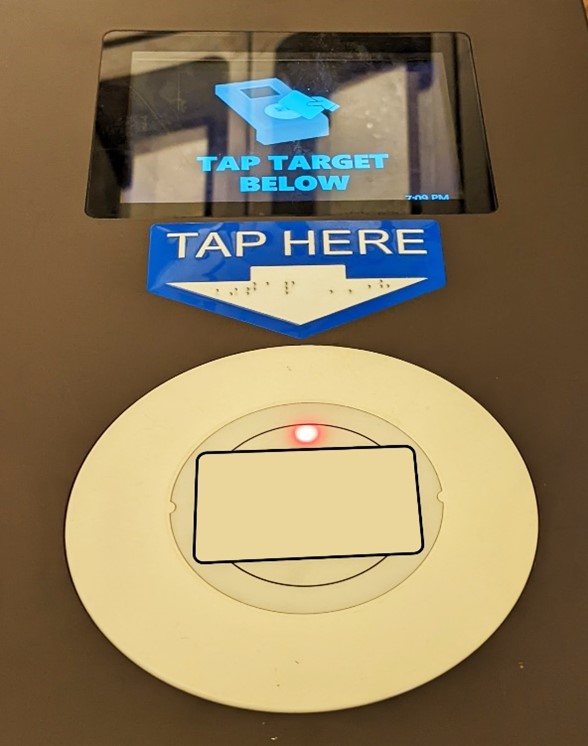
Customer service/help
Charging station operators should provide customer service, help support, or other mechanisms to report outages, malfunctions, obstructed EV chargers, and other issues. Technical requirements for two-way voice communication can be found in Section 508 ( §412 ), and effective communication is addressed in DOJ ADA regulations. Multilingual access may also be required.
Chargers can provide signs or labels with phone numbers/TTY, text message support, or help features integrated into the user interface. Multiple means of communicating audibly and visually should be provided.
If two-way voice communication is integrated into the EV charger, §412 of Section 508 requires:
- Volume gain controls
-
Effective means for coupling with hearing aids.
- This can be a handset conforming to ANSI/IEEE C63.19-2011 or TIA-1083-B.
- For IP-based networks, this can be achieved by conforming with ITU-T Recommendation G.722.2 or IETF RFC 6716
- Audio jacks are the most common approach.
- Any caller ID feature must be both visible and audible
- If video communication is supported, it must be of sufficient quality to support communication using sign language.
- Support for bi-directional text communication, TTY functionality, or compatibility with legacy TTY systems.
Websites and Mobile Applications
Many EV charging stations have websites and mobile applications used to locate charging stations, pay for electricity, start/stop charging, and send notifications to users. These websites and mobile applications must conform to industry standards for digital accessibility. The Department of Justice has guidance on web accessibility and the ADA . Section 508 requires websites and mobile applications to be accessible and incorporates by reference the W3C Web Content Accessibility Guidelines ( WCAG 2.0 ).
Connectivity
Charging Networks should utilize the Open Charge Point Protocol (OCPP) and provide information on accessibility in addition to the connector type, output power, availability, repair status, etc. Specific information on accessibility is more helpful than a generic designation of “accessible”. Specific information could include:
- Accessible Mobility features
- Access aisle left side
- Access aisle right side
- Long charging cable (capable of reaching a vehicle charging inlet regardless of vehicle orientation)
- Reserved (disabled parking placards/license plate required)
- accessible connector (operable by people with limited hand dexterity)
- automatic connection device
- wireless charging
- Accessible Communication features
- accessible user interface (section 508)
- contactless payment
- “Plug and Charge” compatible
Providing pictures of accessible EV charging stations and chargers is also encouraged.
The Access Board welcomes collaboration with the Open Charge Alliance to develop protocols for information on accessibility.
EV Charging Station Location within a Site
An EV charging station must connect to an accessible route that leads to an accessible entrance of the building or facilities on the same site. Additionally, the accessible EV chargers should be on the shortest accessible route to the accessible entrance relative to other chargers at the same charging station.
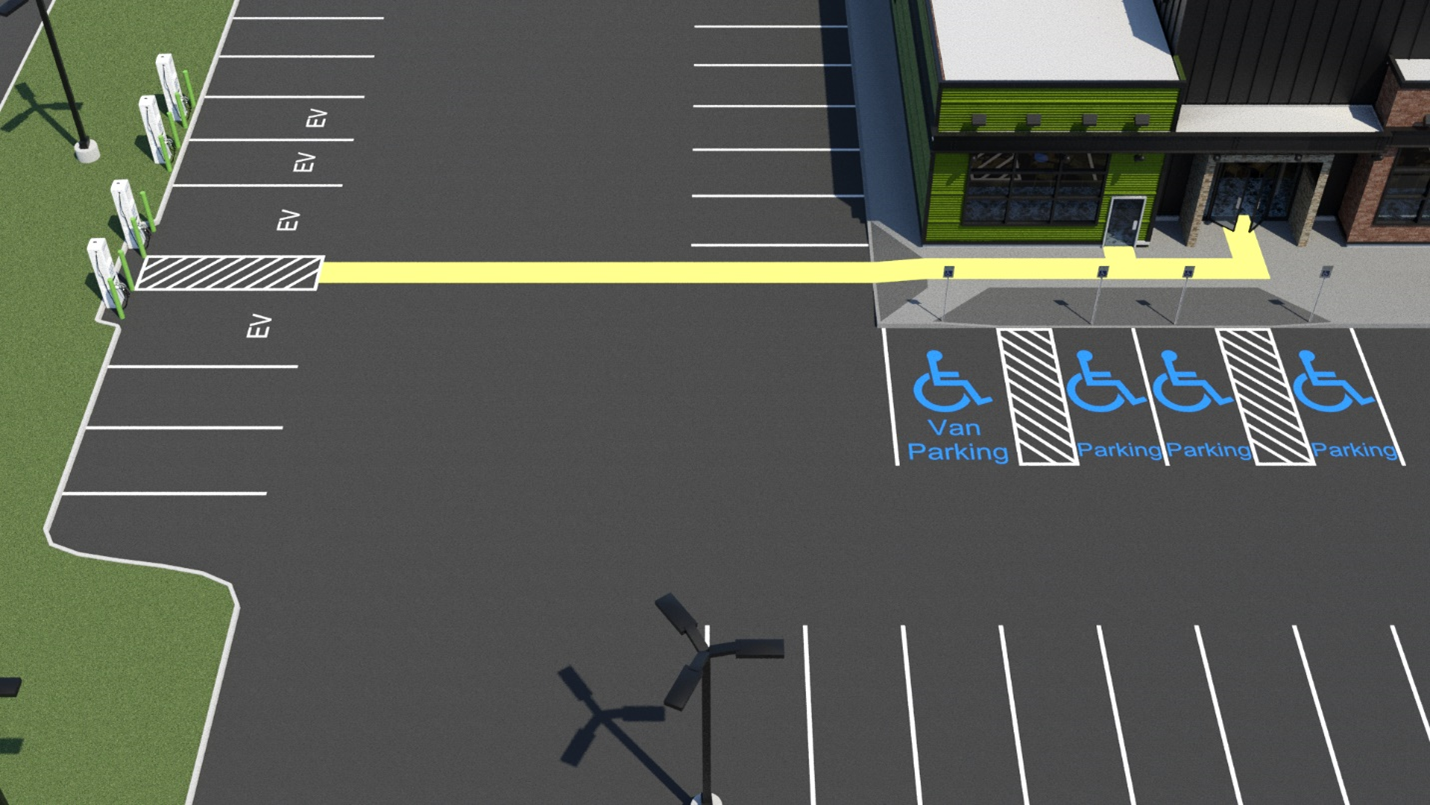
EV charging stations in parking garages must provide an accessible route that connects to the accessible pedestrian entrance of the parking garage. Additionally, a minimum vertical clearance of 98 inches should be maintained throughout the vehicular route to the accessible vehicle charging space and access aisle.
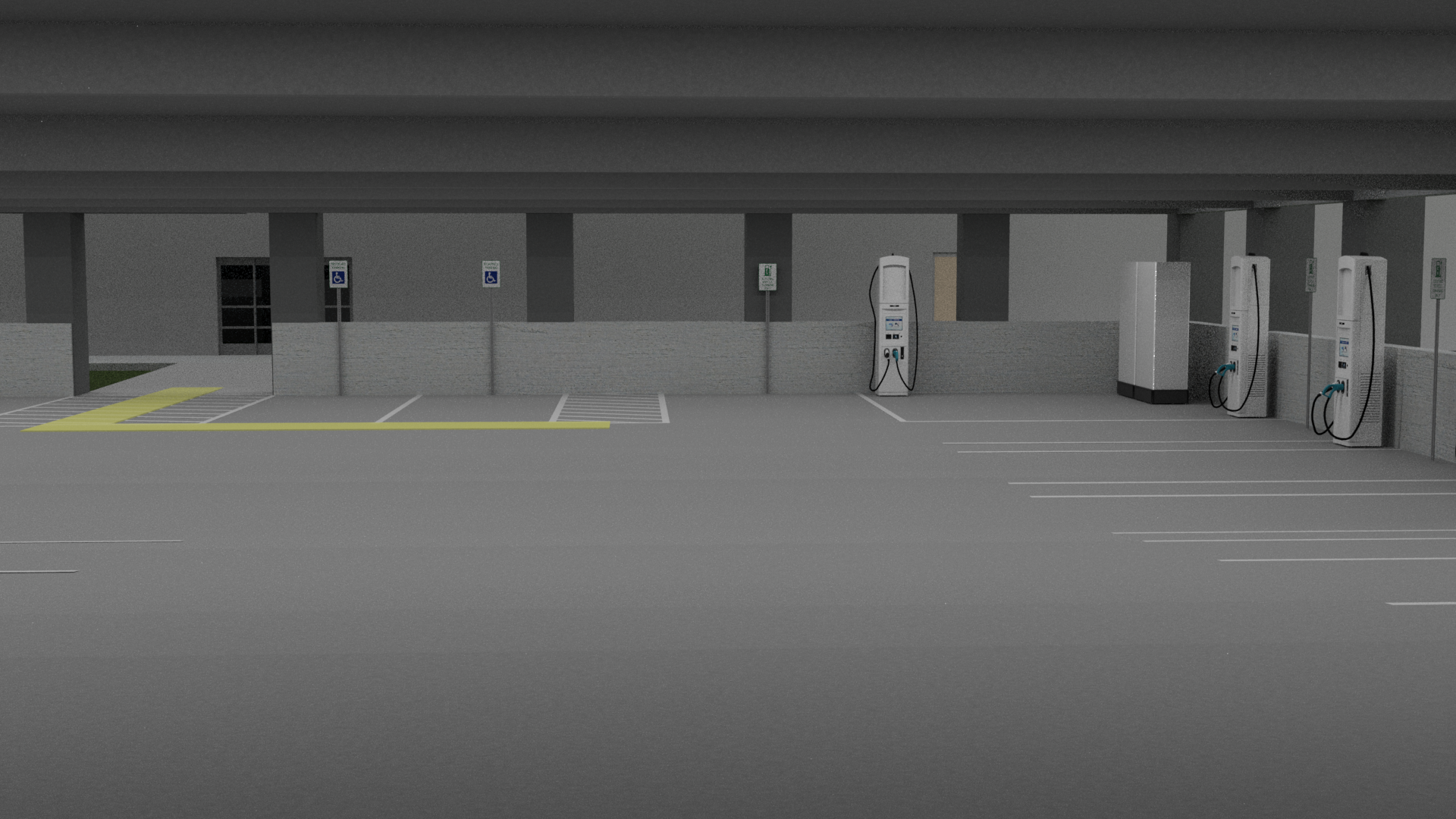
Sites with EV charging stations as the primary purpose should include accessible routes that connect to any amenities on the site and, if provided, a sidewalk in the public right-of-way.
Multiple EV Charging Station Locations within a Site
Some large sites may have multiple EV charging station locations, and an accessible route should be provided at each location, similar to multiple parking facilities on a site .
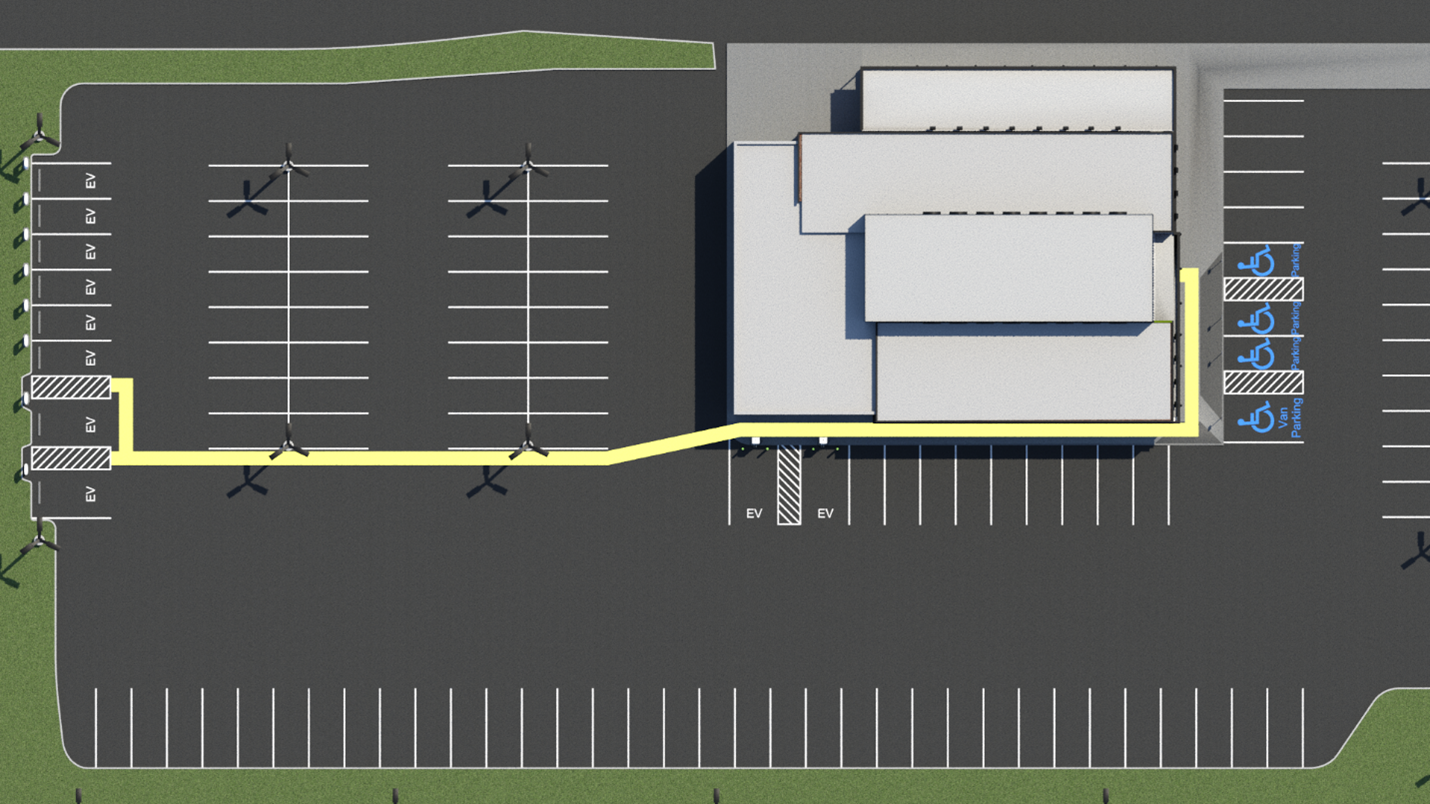
Adding EV Charging Stations to Existing Parking Lots
EV charging stations added to existing sites must comply with the ADA and ABA requirements for alterations and additions. In alterations, compliance with the ADA and ABA standards is required to the maximum extent feasible (§202.3). For more information, please consult the Access Board’s guide on alterations and additions .
When EV charging stations are added to an existing site, they must connect to an accessible route and a reasonable number of EV chargers must comply with §309 and have a clear floor or ground space and operable parts within reach range. Also see: Number of accessible chargers
Converting accessible parking spaces to EV charging spaces is not recommended, especially when use will be restricted to electrical vehicle charging only. The ADA and ABA standards prohibit an alteration that decreases accessibility below the requirements for new construction (§202.3.1). If an existing accessible parking space is converted to an EV charging space, the minimum number of accessible parking spaces required by table 208.2 must be recalculated based on the total number of parking spaces provided, and accessible parking spaces may need to be added elsewhere.
Key considerations when adding EV chargers with accessible mobility features to existing parking facilities:
- Can the chargers be connected by a compliant accessible route to the accessible entrance of the building or facility?
- Is the slope and cross slope of the vehicle charging space less than 1:48? Can the floor or ground surface be altered to achieve slopes less than 1:48?
- Is there sufficient space for an 11-foot-wide, 20-foot-long vehicle space and 5-foot-wide access aisle?
- Can the chargers be placed at the same level as the vehicle charging space? Will existing curbs and landscaping need to be removed or altered to place chargers at the same level as the vehicle charging space?
- Can a clear floor or ground space positioned for a parallel approach with an unobstructed side reach be provided?
- Is the clear floor or ground space firm, stable, and slip resistant?
- If EV chargers must be mounted on a curb, are operable parts of the chargers still within an unobstructed side reach and no farther than 10 inches and no higher than 48 inches above the clear floor or ground space?
- What existing site constraints are there, and would locating chargers elsewhere on the site make them more accessible?
EV Charging Stations at Residential Facilities
Shared or common use EV chargers located at residential facilities provided by a state or local government must be accessible.
EV chargers that are designated to specific residential units should provide the appropriate accessibility features. When residential facilities designate parking spaces to each residential unit, the parking space for the mobility accessible unit must be an accessible parking space (§208.2.3.1). Similarly, a charger provided for a mobility accessible residential unit should have an electric vehicle charging space with accessible mobility features. A charger provided for a communication accessible residential unit should have an electric vehicle charger with accessible communication features. Upon request, additional chargers may need to be made mobility and/or communication accessible.
EV chargers installed at privately-owned residential housing are not subject to the ADA. However, privately-owned multifamily housing may be subject to the Fair Housing Act (FHA) and may be required to be accessible. For more information, contact the Department of Housing and Urban Development (HUD) Fair Housing Accessibility First at 1-888-341-7781 or FairHousingFirst@hud.gov.
EV Charging Stations in the Public Right-of-Way
EV chargers installed in the public right-of-way have unique design challenges due to existing sidewalks and infrastructure that may make installing chargers at the same level as the vehicle charging space technically infeasible.
On-Street EV Charging Stations Design
EV chargers installed on the sidewalk for on-street parallel parking should locate chargers with mobility features at the end of the block, or at the closest curb ramp. Section R309 of the proposed Public Right-of-Way Accessibility Guidelines provides design requirements for accessible on-street parking spaces, which can be used to design accessible charging spaces.
Chargers can be placed on narrow sidewalks but should be oriented facing the sidewalk and not the street in order to ensure there is adequate clear floor or ground space in front of the charger to allow for a person with a disability to approach and operate the charger. Chargers should not be placed within the middle 50% of the sidewalk adjacent to the on-street parallel parking space because this design would obstruct entry to and exit from the vehicle.
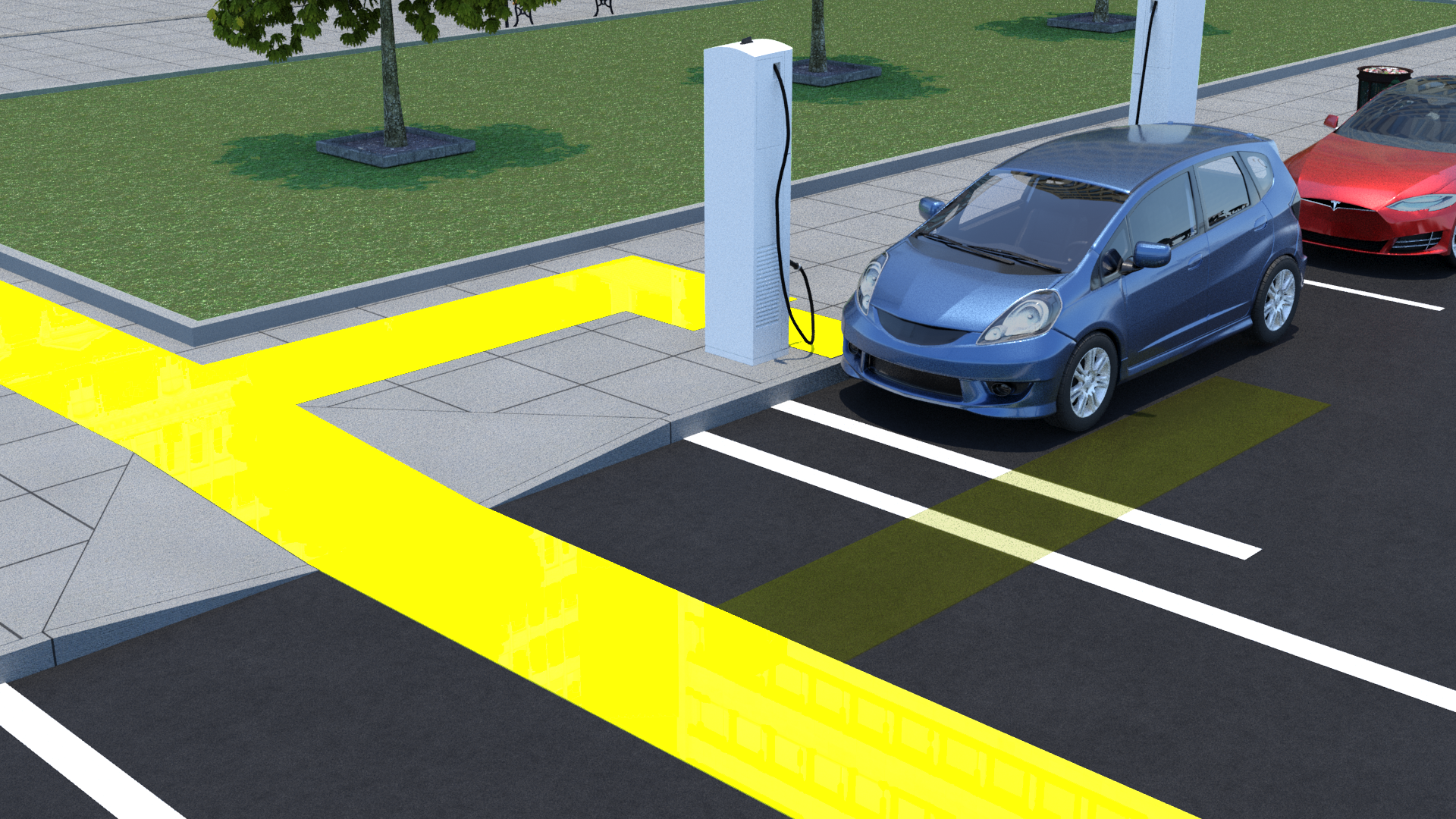
It may be challenging to bring the charging cable out to the street to connect to a vehicle with a charging inlet located on the street side, so use of chargers at on-street parallel parking may be limited to charging electric vehicles with charging inlets located on the same side as the sidewalk. Providing chargers on both sides of one-way streets is a more accessible option.
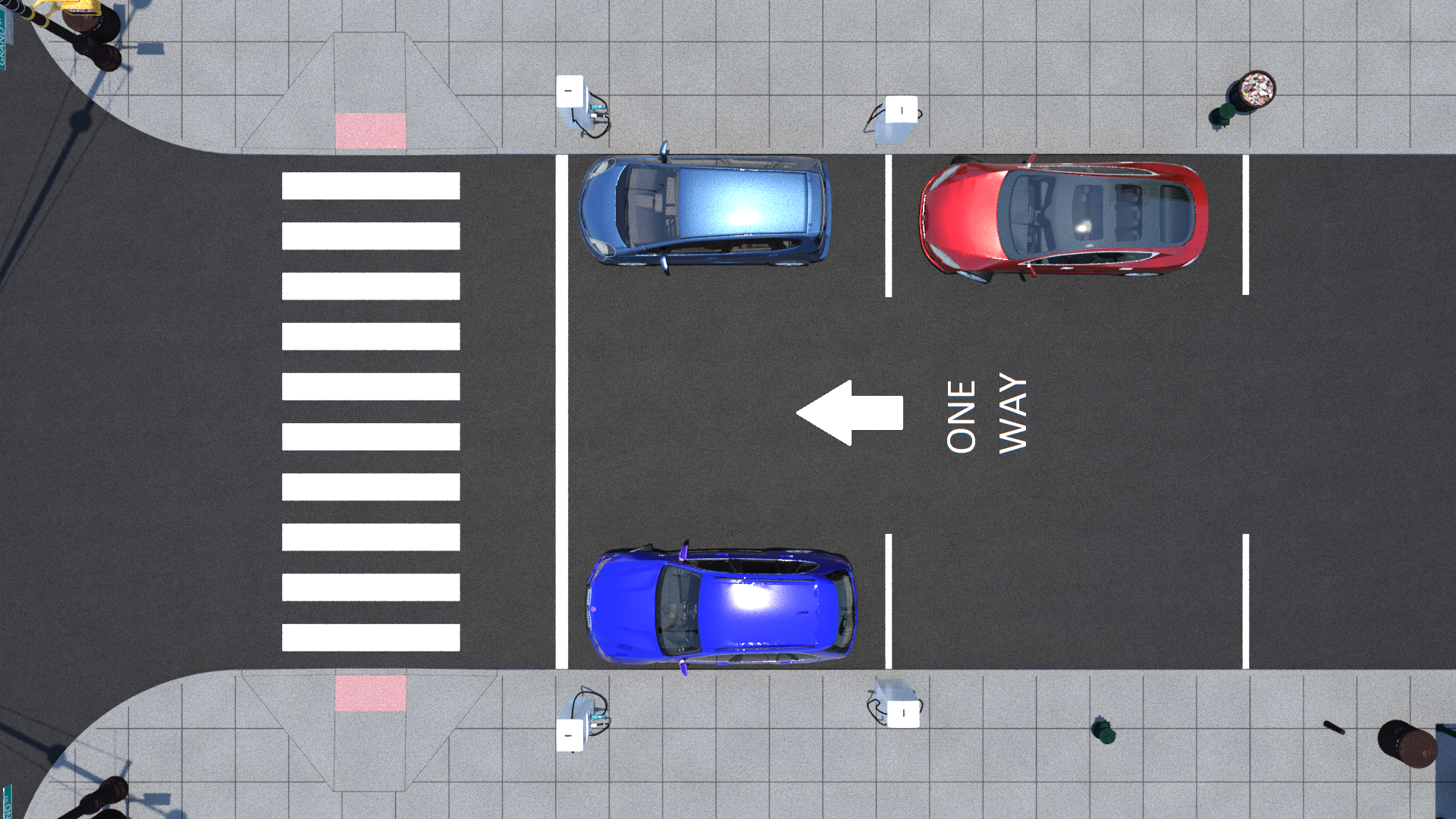
On-street parking with wide sidewalks complying with § R309.2.1 have 5-foot access aisles at street level. EV chargers can be provided at the ends of the space or along the side up on the sidewalk. Clear floor or ground space at EV chargers, access aisles, and accessible routes must not be obstructed by bollards, curbs, trees, grass, garbage cans, etc. Accessible routes must not be blocked when cables are connected to vehicles.
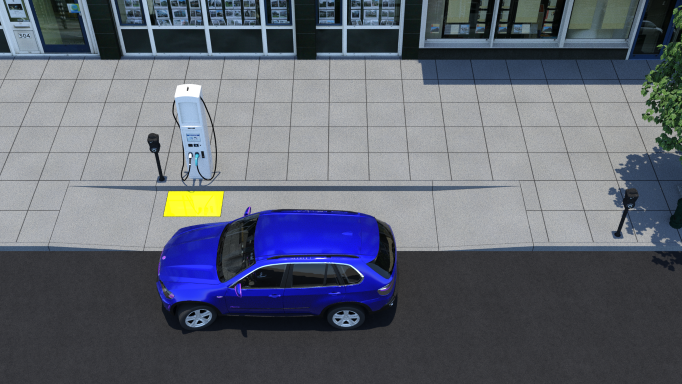
Fleet Electric Vehicle Charging Stations
Fleet vehicles are cars owned by an organization (business, nonprofit group, or government agency). Under the ABA, fleet EV charging stations at facilities designed, built, altered, or leased with federal funds for charging organizations’ vehicles must be accessible.
Fleet EV charging stations that serve various businesses are considered a place of public accommodation or commercial facility and must comply with the ADA Standards. Examples include a vehicle manufacturer that installs charging stations to serve its corporate fleet customers.
Employee Use of EV Chargers
Under §203.9 of the ADA Standards, entities subject to Title II or Title III of the ADA may be eligible for an exception for EV charging stations provided at a commercial facility for charging fleet vehicles under the employee work area exception if charging stations are used only by employees for charging company/fleet vehicles. However, it is recommended that at least one EV charger have accessible mobility features to accommodate employees with disabilities because the employer may be required to provide an accessible EV charger if requested by an employee as a reasonable accommodation.
If charging stations are provided for employees to charge their personal vehicles, the employee work area exception would not apply and EV charging stations must be accessible.
EV chargers provided for specific employees to charge their personal vehicles should provide accessibility as needed.
Pull-Through EV Charging Stations Design
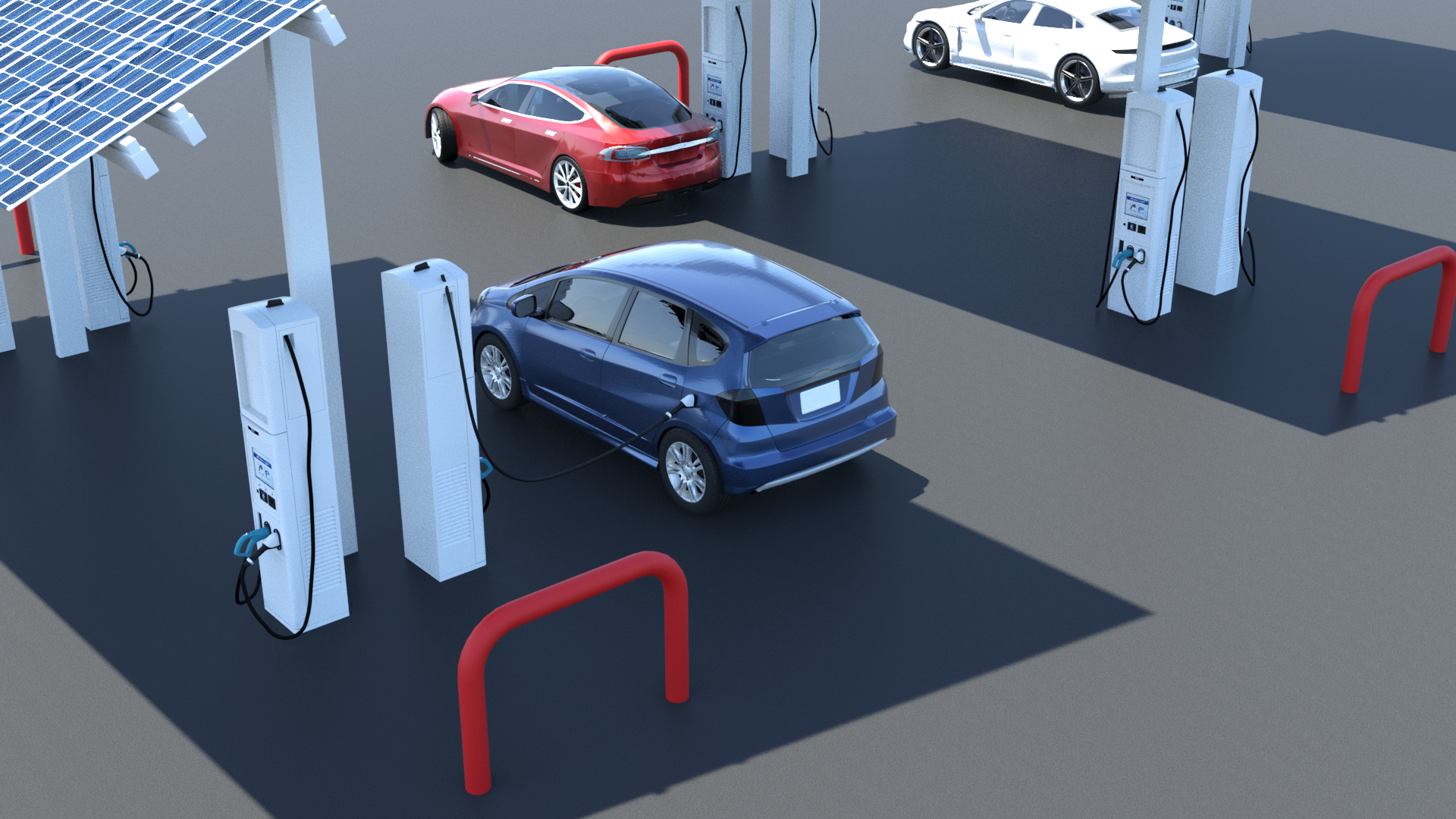
As EV charging gets faster and more EVs become capable of towing, EV charging stations may be designed for pull-through or drive-up access, similar to gas stations. Pull-through EV charging stations do not need to mark or stripe vehicle charging spaces, but they should provide at least sixteen (16) feet of width for vehicle charging spaces. Charging cables should be able to connect to a vehicle positioned five (5) feet away.
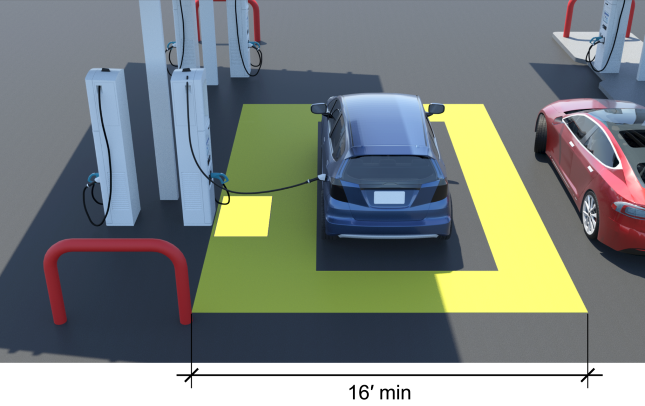
Chargers with accessible mobility features must have a clear floor or ground space and operable parts within reach range (i.e., less than 48 inches above the ground). Bollards aligned with the sides of EV chargers provide protection without obstructing use. Designing all pull-through EV chargers with accessible mobility features is encouraged and can be achieved by avoiding installation on curbs. If installation on curbs is required, it is recommended to create a cutout in the curb that allows the clear floor or ground space to be placed closer to the charger. Also see: Are EV charging stations considered fuel dispensers and eligible for the reach range exception #2 in 308.3?
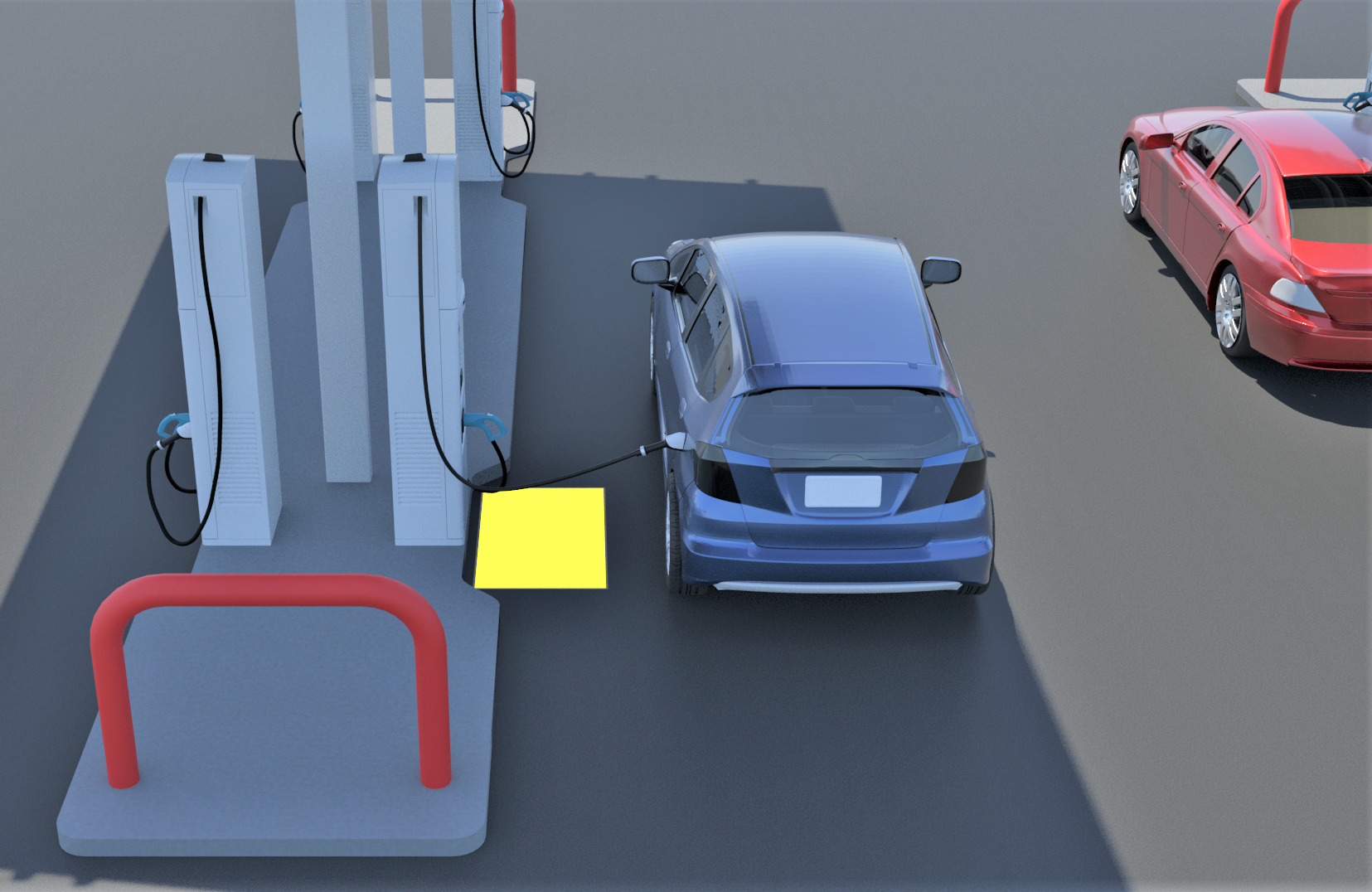
The use of automatic connection devices is encouraged at fleet charging stations, especially when chargers serve a specific vehicle make and model. If/when very short charging times are achieved, it may be unnecessary to exit the vehicle for charging.
Other Considerations
Lighting
The use of lighting can be an effective way to indicate where an EV charging station is located within a site. Lighting can also be an effective way to indicate which chargers are accessible, which are in use, in which are not working. Lighting also helps with the operation of the charger, including plugging the connector into the vehicle charging inlet at night.
Shelters
The use of shelters to protect EV charging stations and their users from the elements (rain, snow/ice, and extreme sun/heat) is also recommended. Snow and ice can be difficult, if not impossible, for a mobility device user to traverse over. Plowed snow should not obstruct access to and use of the EV charger. Black charging cables in the extreme sun/heat can also burn people with limited sensation. Shelter supports, such as columns and pylons, should not be installed in or obstruct vehicle charging spaces or access aisles, and must not be installed in or obstruct clear floor or ground space and accessible routes.
Innovation
Innovations in automatic connection devices and wireless or inductive EV charging can greatly improve accessibility. This could simplify the charging process, including the potential to eliminate the need to access and operate the charger. If/when very short charging times are achieved, it may be unnecessary to exit the vehicle for charging.
Number of Accessible Chargers
The ADA and ABA Guidelines do not specifically address how many chargers must be accessible at an EV charging station. Under the ADA Standards, when a facility or element does not have specific scoping requirements, access to a “reasonable number” is required under the general prohibitions against discrimination in the Department of Justice (DOJ) regulations for Title II and Title III entities. For more information, please contact the DOJ Office of Civil Rights at 1-800-514-0301 or 1-800-514-0383 (TTY).
This “reasonable number” must be accessible to and usable by people with disabilities, and where appropriate technical requirements for elements and spaces are provided in the ADA Standards, a reasonable number must meet those technical requirements.
The Access Board will be issuing a Notice of Proposed Rule Making that will solicit comments from the public on the minimum number of chargers that must be accessible at EV charging stations. Several approaches are possible, including:
- a minimum number based on the table in 208.2 for accessible parking spaces
- aligning with the 2021 International Building Code (IBC) that requires 5%
- a “use last” approach where a higher percentage have accessible mobility features, but are not reserved or restricted to people with disabled parking placards/license plates. See more on the “use last” approach
- a hybrid approach of use last and reserved
Issues concerning signage at accessible EV charging spaces include use of the ISA and how to indicate if accessible charging spaces should be reserved for use only by people with disabilities, or available for use by people without disabilities when all other chargers are being used.
In the interim, several states have already issued accessibility requirements for EV charging stations. If a state or local code requires a minimum number of chargers be accessible, at least that minimum number must be provided.
Signs displaying the ISA are not recommended at accessible EV charging spaces at this time, unless required by a state or local code.
The Access Board recommends designing at least two EV charging spaces with accessible mobility features, and providing accessible communication features and operable parts at all EV chargers.
This can be achieved with the following example EV charging station designs:
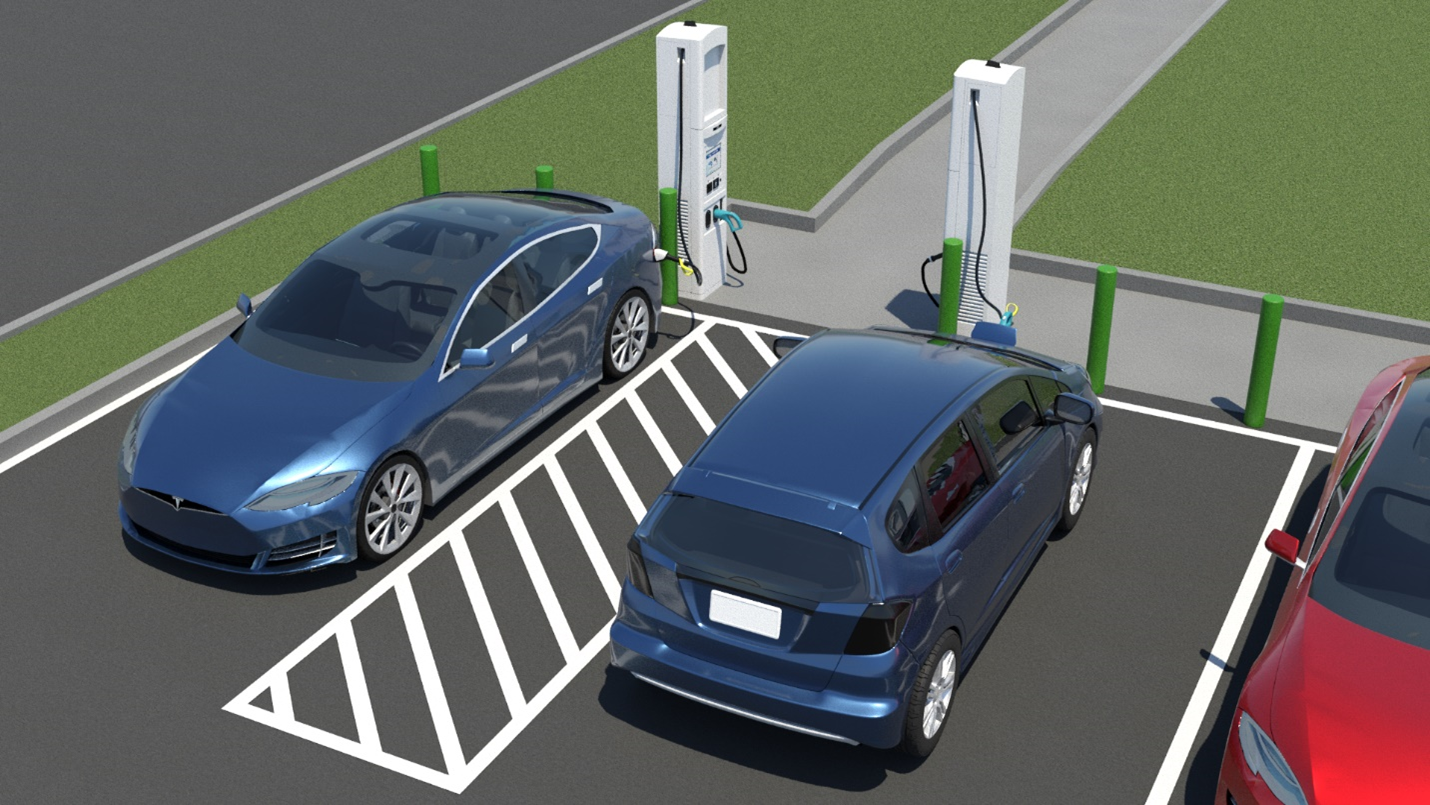
“Use Last” Approach to EV chargers with accessible mobility features
Traditionally, accessible parking spaces are identified with the International Symbol of Accessibility (ISA) and reserved for use only by a person with a disability placard or license plate. Use of the ISA at EV charging spaces causes confusion about whether people without a disability placard can use accessible EV charging spaces. Since EV charging stations usually have only a few chargers, reserving a charging space only for use by a person with a disability placard may result in underutilized chargers.
The “use last” model would require more EV charging spaces be designed with accessible mobility features, but would not require that the charging spaces be reserved exclusively for people with disability placards. People without disability placards could use accessible EV charging spaces when all others are occupied, resulting in greater use of available chargers. This would allow mobility device users to have more options to find a charging space with the ideal design for their EV, and alternative charging spaces to use if a charger is broken or obscured. Having alternatives is extremely important, especially if the next accessible charging station is very far away.
A “use last” sign would indicate an EV charging space is accessible, but also direct people to use this space only when other charging spaces are occupied or accessibility features are needed.
At the time of this guidance, neither Manual on Uniform Traffic Control Devices (MUTCD) nor any other code-setting organization has a standard for “use last” signs, but the Access Board has designed several examples.
![Examples of use last signage. The first sign says accessible EV charging [EV charging logo] use last. The 2nd sign says [EV charging logo], accessible EV charging use last. The 3rd sign says designed for disability access use last. The 4th sign says use last design for accessibility. All signs are blue and white.](/images/tad/ev/ev-figure-50.png)
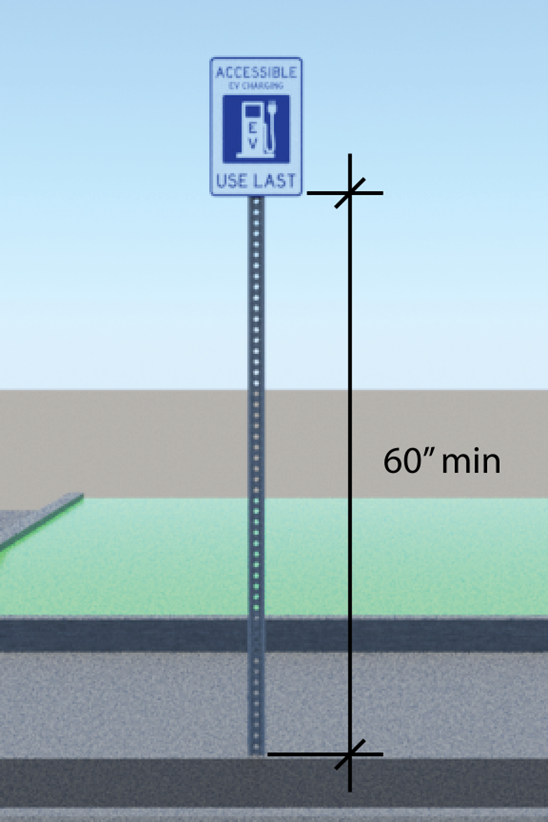
Technical Assistance
The Access Board provides technical assistance on the ADA accessibility guidelines and on accessible design through its toll-free helpline at 1-800-872-2253 and by email at ta@access-board.gov from 10:00 a.m. to 5:00 p.m. (ET) weekdays.
Common questions
EV charging stations that serve a variety of vehicles or have a variety of chargers (i.e., different charging levels, connectors etc.) should prioritize access to chargers with higher rated power output and CCS connectors. Networked charging stations should indicate the accessibility of the charging station in addition to the connector type, power output, and availability status so people with disabilities can accurately identify accessible chargers that have the connector type they need.
If there are state or local codes that require a certain number of accessible EV charging stations be designated with the International Symbol of Accessibility (ISA), it is recommended to meet state or local code requirements. In the absence of a specific requirement, the ISA is not currently recommended for use at EV chargers with mobility features, however other signs (such as the proposed “use last” sign) that indicate accessibility are encouraged.
Mobility device users need an extra three (3) feet of space to maneuver around the EV charging space and reach the vehicle charging inlet. Coincidentally, this aligns with the size for a van accessible parking space. This is sufficient space for a mobility device user who is able to transfer in and out of the vehicle’s driver seat, but it may not be sufficient for a mobility device user that uses a ramp or lift equipped wheelchair accessible vehicle (van).
As of the writing of this guide, there is no known wheelchair accessible battery electric vehicle and only a handful of wheelchair accessible plug-in hybrid vehicles that have a rear entry ramp and are not designed to be driven by a wheelchair user.
Development of wheelchair accessible electric vans are in process, but the location of the vehicle charging inlet is not clear. Most electric vans place the inlet in the front of the vehicle, and it is predicted that accessible electric vans will provide a ramp or lift on the passenger side of the vehicle, although it is possible ramps may be provided at the rear or driver side.
Charging inlets that are located on the same side of the vehicle as the ramp or lift are ideal because an access aisle would only be required on one side of the vehicle. A charging inlet located at the front of the vehicle may also work. However, charging inlets located on the opposite side of the vehicle ramp or lift would require even more space than the sixteen (16) feet for vehicle charging space and access aisle recommended in this technical assistance document.
No. A commonly used definition of a fuel dispenser is a machine at a filling station that is used to pump gasoline, petrol, diesel, CNG, CGH2, HCNG, LPG, LH2, ethanol fuel, biofuels, such as biodiesel, kerosene, or other types of fuel into vehicles.
Fuel dispensers were given an exception due to the mechanics of pumping fuel from below the ground, which required installation on existing curbs. EV charging stations installed in parking lots and ground surfaces where the electrical conduit can be located below ground should not need an exception to the 48-inch maximum reach range requirements. However, there may be times when it is technically infeasible to place electrical conduit belowground. For example, the installation of EV chargers in an existing multilevel parking garage may require installing the chargers on a platform above the concrete slab. In this case, it may be technically infeasible to comply with the 48-inch reach range requirements and reach ranges greater than 48 inches may be complying to the maximum extent feasible.



